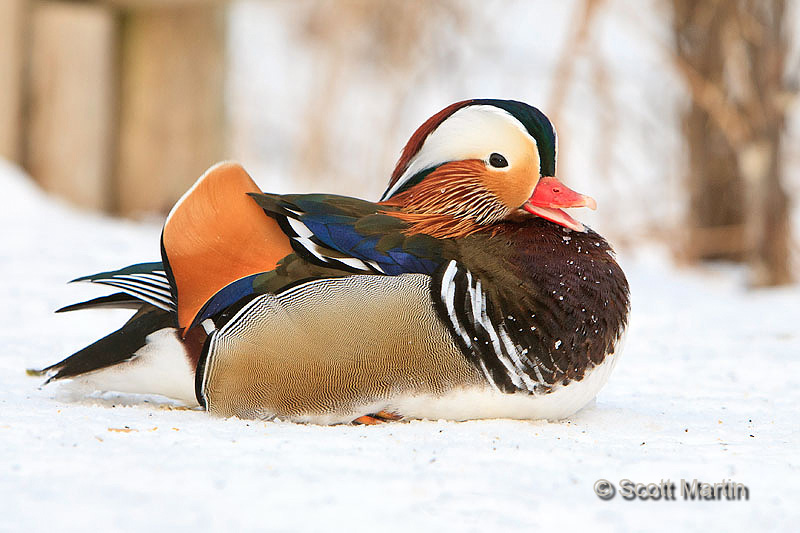
by Scott Martin Photography | Jan 4, 2014 | Birds, Blog, Shore Birds & Waterfowl, Wildlife
The Mandarin Duck is a local rarity and a bird I had never seen before in the wild so when a single drake showed up in Whitby it created quite a flurry of interest.
The Mandarin Duck is an East Asian perching duck found primarily in Russia, China and Japan. It is a medium sized duck and is closely related to the North American Wood Duck and is similar in that they both nest in empty tree cavities, sometimes as high as thirty feet above the ground. After the chicks are born the mother pushes them out of the tree and then leads them off to the nearest body of water. Mandarin Ducks are among the most beautiful and colourful ducks as the following pictures shows.

When shooting birds on the ground it is important to get the camera at their level in order to achieve the best results. The above shot was taken while lying down on the ground resting the 70-200mm lens on the palm of my hand. The next image was taken from a sitting/kneeling position to show the colour ranges and feathers detail on the dorsal aspect of the bird. Although the shot accomplishes the purpose you can clearly see the better perspective of the first image. So next time you are photographing anything on the ground, don’t forget to lie down and get the job done right!
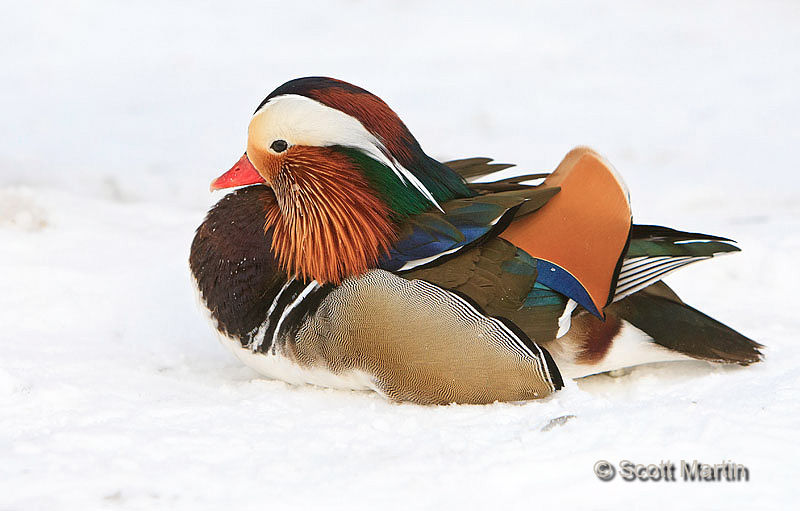
Although there are a few feral colonies of Mandarin Ducks in North America, they were probably created by the escape of bids from captive collections (i.e., zoos). It is unlikely they are a result of misplaced migration from East Asia. In all probability the Mandarin drake that arrived in Whitby is an escaped captive bird.
The only open water for this duck is a pool created by the fast flowing water from a couple of late drainage pipes that is only about thirty feet in diameter. This little Mandarin Duck shares the small pool with about a hundred Mallard ducks and a few Canada Geese so it was very difficult to get any images of the Mandarin alone in the water. The following three are the best I could do.
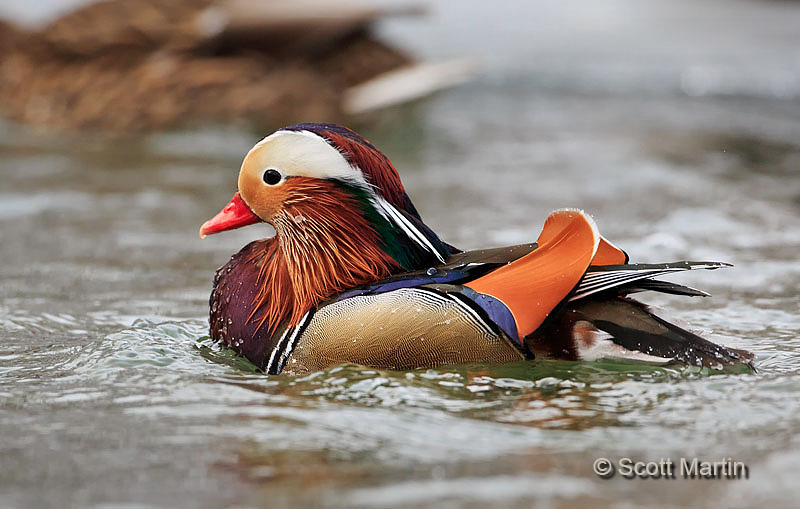
Frolicking
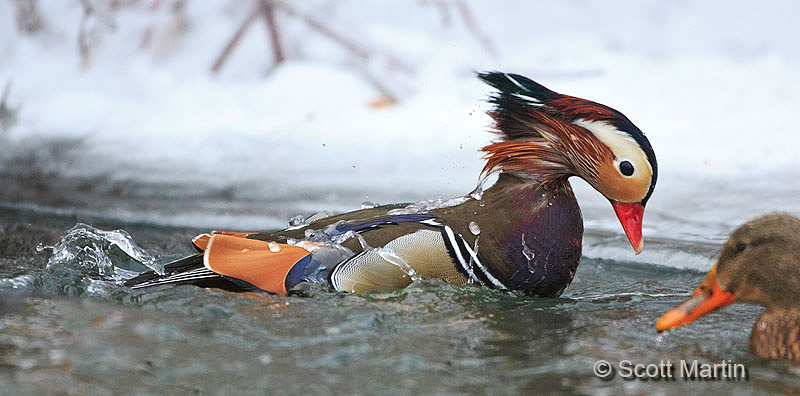
Water off a duck’s back!
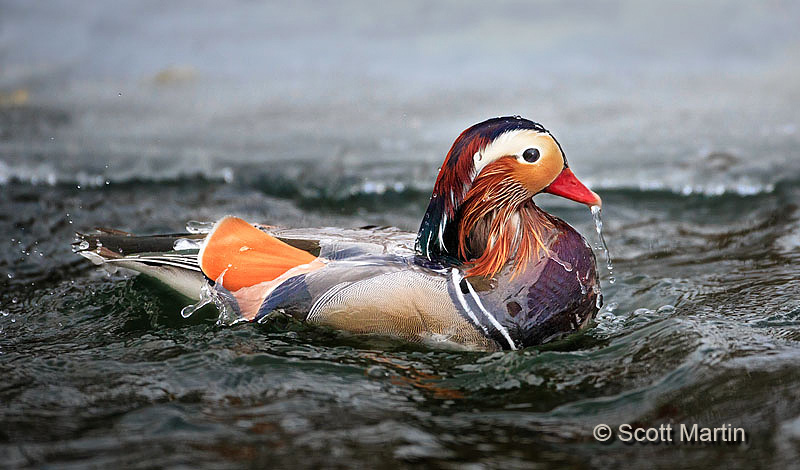
When photographing wildlife it is always best to take lots of exposures when the target is in your viewfinder as the spontaneous nature of wild animals often presents some interesting even humorous actions. This is completely different from landscape photography where the subject doesn’t move and you can invest as much time as necessary to plan, compose and execute the ‘perfect’ single image and then move on to the next shot.
Spontaneous ‘snapshots’ don’t have to be perfectly composed with tack sharp focus (although it helps) as long as the story the image tells or the smile that it creates is the overarching result of the photograph. Here are a couple of such snapshots obtained while photographing the Mandarin Duck this week. Although not typical images for posting on photography blog designed to showcase great photography, I do trust you enjoy them and they give you a smile.
Stepping out with the big boys! (this does provide a good perspective for appreciating the size of the Mandarin Duck).
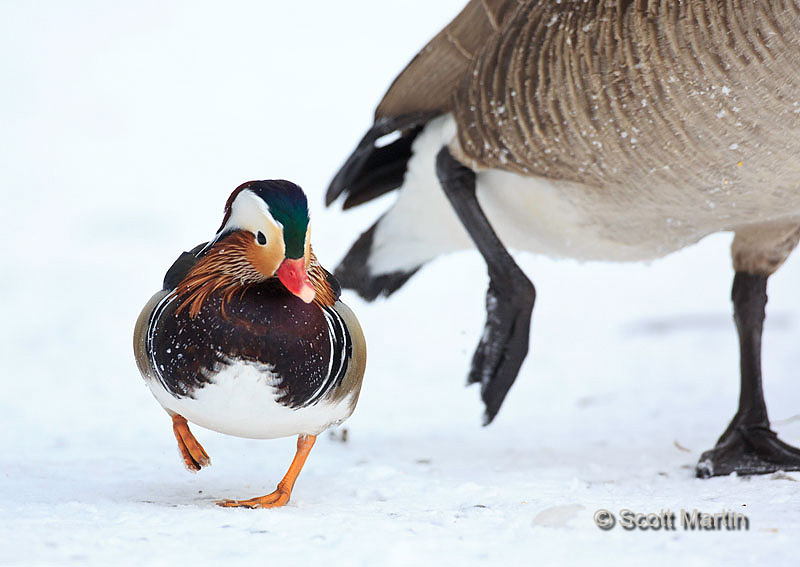
Where angels fear to tread.
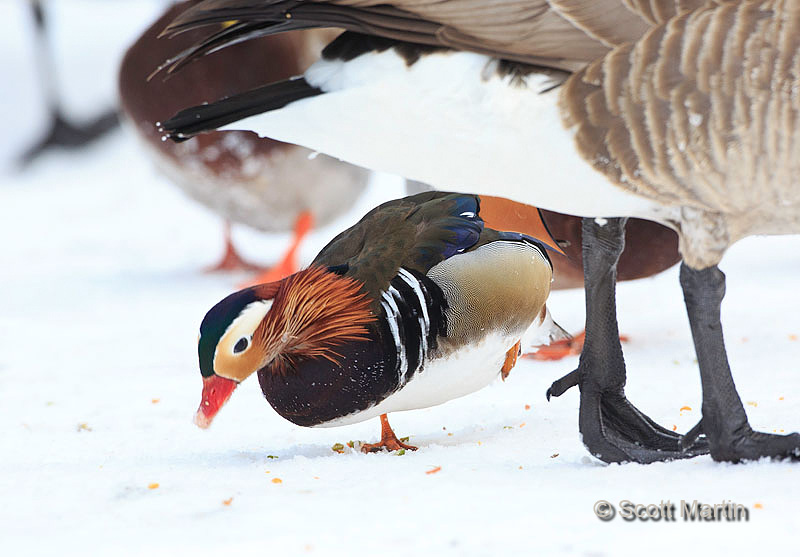
The first two images in this post were taken handheld with the 1D Mk III and 70-200mm/2.8, while the three shots of the duck on the water were using the 5D Mk III and 500mm/4, again handheld. Although these body/lens combinations may seem odd, some thought went into them. The 1D body has a crop factor of 1.3 meaning that a 100mm lens functions like a 100 x 1.3 = 130mm lens when attached to the crop body. So a crop body lengthens the effective reach of the lens compared to the same lens placed on a full frame camera like the 5D. Knowing that it was possible to get relatively close to the ducks, putting the crop body on the smaller lens and the full frame body on the longer lens created the optimal effective focal ranges for getting the best pics of the Mandarin Duck.

by Scott Martin Photography | Jan 1, 2014 | Blog, Educational, Landscapes, Naturescapes
Happy New Year to all of you who have followed this blog over the past year and I trust each and every one of you will enjoy a wonderful New Year in 2014, full of God’s blessings.
This will be a short post today and something completely different from the norm in that it will be a bit of a tutorial, so your feed back would be appreciated.
Christmas of 2013 in our area will forever be remembered for the ice storm that blanketed southern Ontario and caused power outages on a huge scale, affecting millions of people and leaving thousands of homes in the Greater Toronto Area without power for over a week. Our home in Oshawa was relatively unscathed, being without power for about half a day and an Ash tree in our front lawn suffering major damage (and perhaps may have to come down). Although the ice storm caused major destruction, it also allowed for some great photographs opportunities which actually lasted for three or four days before the sun came out and temperatures rose sufficiently to melt the ice. All of the images in today’s post are of a Flowering Crabapple tree located in the front yard of our home. Each image was taken using the Canon 5D MkIII and EF 100mm f/2.8L macro IS USM lens mounted on a tripod.
This first image is the final result after much experimentation to achieve the desired outcome; bright red Crabapples encased in ice with a snowy frosting and winter back ground.

Its important to consider the back ground (BG) of every image taken and if possible develop a BG that adds to the effectiveness of the image by isolating the object of the photograph from the BG. Classically, look for uncluttered BG’s that are out of focus, factors that help create separation between the object and its surroundings and therefore draws one’s attention to the object of the photograph. Technically this can be accomplished by two methods; when possible increasing the distance between the object and and BG, and increasing the aperture on your lens (lower f-stop) which reduces the depth of field (DOF; the distance range perpendicular to the lens that remains in focus).
The next three images are all taken with the same camera position as the image above, however the BG is the brick siding of our next door neighbour’s house. They show the relationship between aperture and depth of field and that even when a BG is separated from the object and out of focus, colour has a huge impact on the final result!
f/32 ISO 100 1/2 sec (smallest lens aperture, maximum depth of field, bricks recognizable but out of focus due to distance from object).

f/10 ISO 100 1/20 sec (less depth of field, bricks almost unrecognizable and crabapples in reasonable focus throughout)

f/2.8 ISO 100 1/125 sec (minimum depth of field, bricks unrecognizable however crabapples not in focus due to extremely shallow depth of field)

Some may prefer the f/2.8 image while others may prefer the f/10 version as more of the object remains in good focus. A little bit of photoshop on the f/10 version improves the image about as much as can be accomplished given the colour of the brick BG.

Not being happy with the colour of the BG I decided to use a 48″ white/silver reflector (which is typically used to reflect light onto a person during portrait photography) to create the appearance of a snowy BG. Intuitively I selected the white reflecting surface which produced the following result.

Although this is an improvement, all the detail in the ice covering the branches is lost and the structure within the icicles is greatly reduced using the white reflector. This led me to try something that was quite counter intuitive which was to use the highly reflective silver reflector and take the shot one more time which produced the results shown in the first image which has lots of detail in the ice, snow flakes and icicles that was absent using the white reflector. Here it is again with a little text in keeping with the date today.

The above image was relatively simple to take in that separating the subject from the BG was easy, the back ground was uncluttered and there was even room to place our own BG into the image. It may have taken some time and experimentation but the process was not a difficult one…..you just have to do it 🙂 But what about situations where you are faced with a cluttered BG that can not be separated from the object? In that case all we have to play around with is the depth of field which we do by changing the aperture of the lens. Remember: larger aperture (lower f-stop) has a shallow DOF while a smaller aperture (higher f-stop) has a deeper DOF. As an aside, focal length of the lens also affects DOF. A wide angle lens (shorter focal length) has a greater DOF than a telephoto lens (longer focal length) at the same aperture.
Here is a different branch of our Crabapple tree with a very cluttered and close BG in which I’ve purposely positioned the object branch at an angle to the lens which makes DOF considerations all the more challenging.
The first image f/32 ISO 100 1/2 sec. Things are in focus but there is no obvious object to be found. An all around poor image which even includes the windows and bricks on our house.
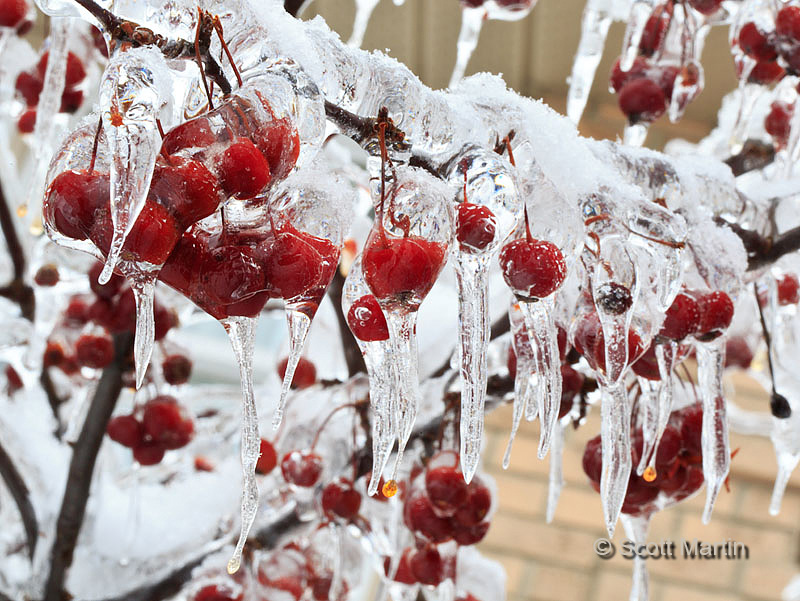
At f/2.8 ISO 100 1/320 sec things start to improve, an object is clearly identified but compositionally it is in the middle of the frame….a big mistake.

Focusing on the Crabapple cluster in the left of the frame at f/2.8 to improve the composition doesn’t work well as the DOF is so shallow you can not visually lock onto the object and therefore the image does not hold any interest.
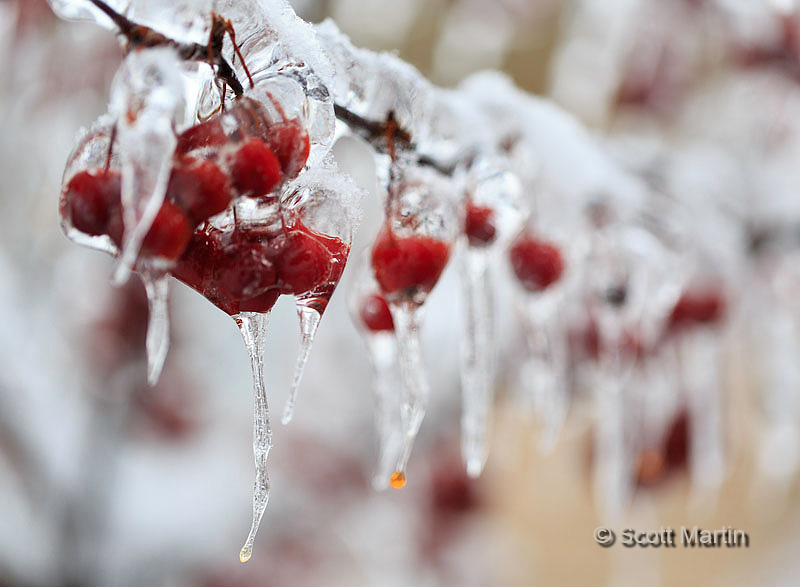
So what can you do? Probably the best thing to do at this point is to agree that the ‘perfect shot’ is not coming from this set up and move on, however with todays digital files and photoshop we can quite easily blend multiple images into one final image. The most complicated form of this process is know as focus stacking where one will take tens (or even hundreds) of images of the same subject slowly moving the focus point from the front to the back of the object and then put all these images together to create an image where the entire object appears in perfect focus even though each individual image in the stack had a very shallow DOF. The simplest form of this process (and the least desirable in terms of results) is to put two images together. This last image is a blending of the f/32 and f/2.8 images above. If you look closely you will see the downside of the two image process but I trust this example shows the possibilities exist so that with patience and thinking things through you can often achieve results that will turn your snapshots into photographs!

I trust this was a helpful post and now its back to working on posts of our European trip.
Happy New Year!
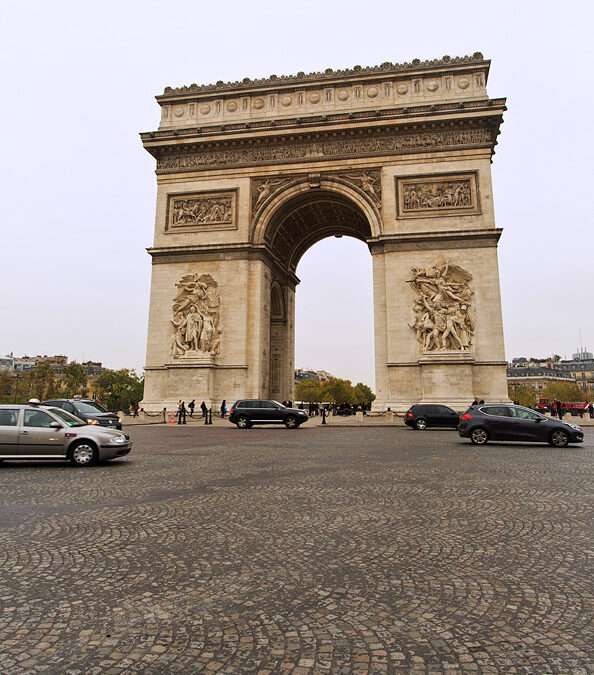
by Scott Martin Photography | Dec 21, 2013 | Blog, Cityscapes, Landscapes, Travel
After leaving Geneva we headed northwest for the 550km trek to the great city of Paris, where we stayed for three days at the Hotel Pullman Paris Tour Eiffel close to the base of the iconic tower which will be the focus of the next post.
Paris is the largest city in France with a population of more than two million and a metropolitan area of over twelve million people. It is located on the River Seine where it was first settled over two thousand years ago.
The Avenue des Champs Elysées is probably the most famous street in Paris, stretching almost two kilometres between the Arc de Triomphe to the west and Obelisk de Luxor to the east. It is home to some of the most expensive real estate, high end fashion boutiques and jewelry stores in the world.
Place Charles de Gaulle is a large area that serves as the origin of twelve straight roads including the Champs Elysées that spread out like giant spokes in a wheel. In the centre of the place is the Arc de Triomphe. This makes the Arc de Triomphe the centre of one of the busiest and scariest roundabouts in the world. It is said that there are eleven lanes of traffic circling around the Arc with absolutely no lane markings on the cobblestones that make up the roadway. It was fascinating to observe and I’m very happy we left our rental car at the hotel and walked.
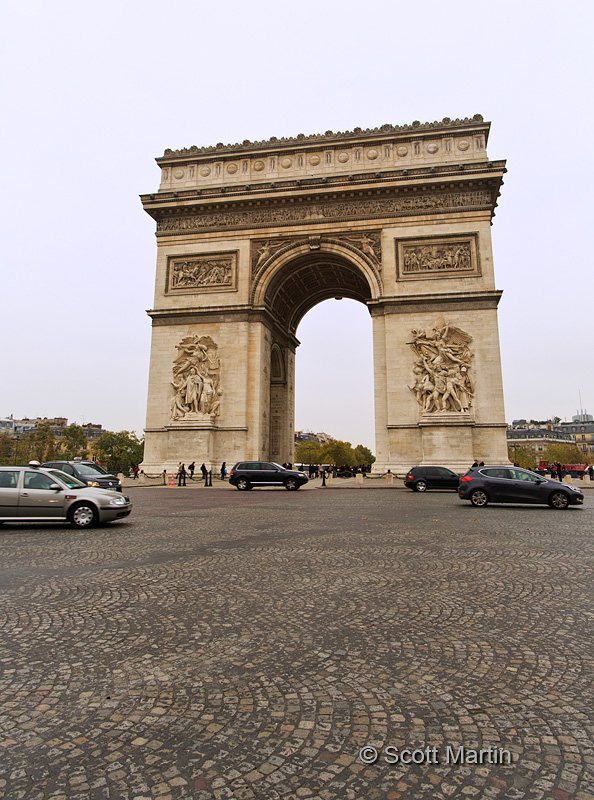
The Arc was commissioned in 1806 but not completed until about thirty years later. It was patterned after the Arch of Titus in Rome and was built to remember the French soldiers who fought & died in the French Revolutionary and Napoleonic wars. Below the arc is the Tomb of the Unknown Soldier remembering those who perished in the First Great War.
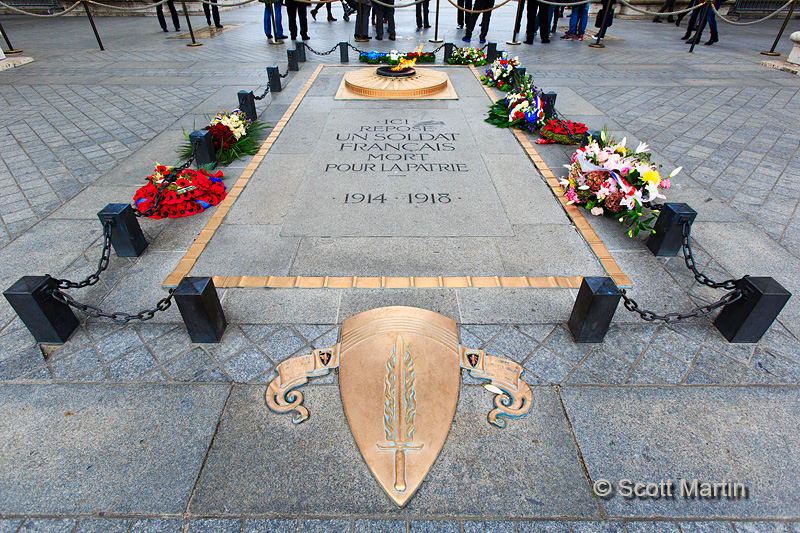
The names of those remembered are carved on the walls of the Arc, while the arches are intricate marble tiles which makes for an interesting wide angle shot looking up from the centre of the Arc.
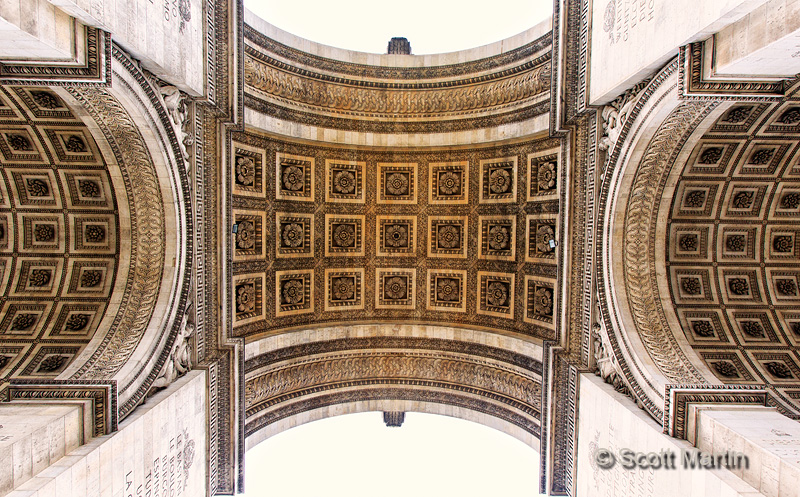
The Arc de Triomphe was fun to photograph at night as the hundreds of cars that are racing around its base provide some interesting lighting effects.
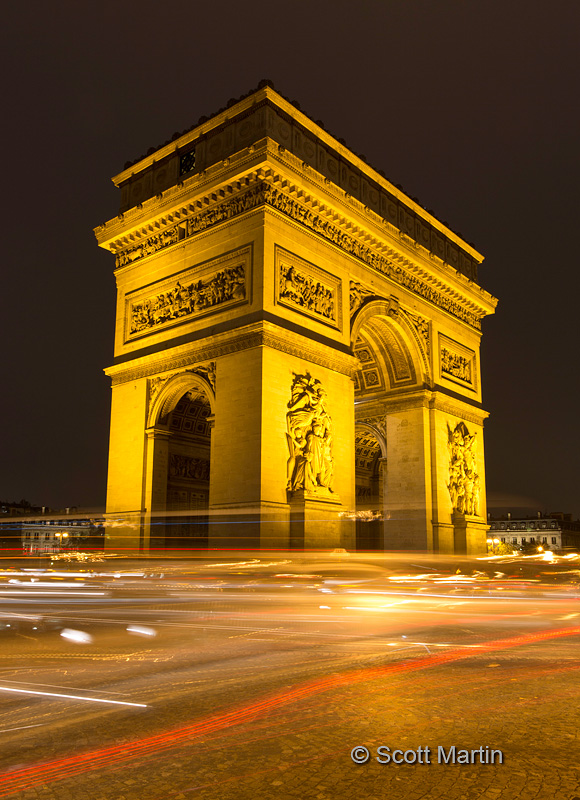
I didn’t notice the dog in the back of the car while taking this next shot, however it has become one of my favourite elements of the image.
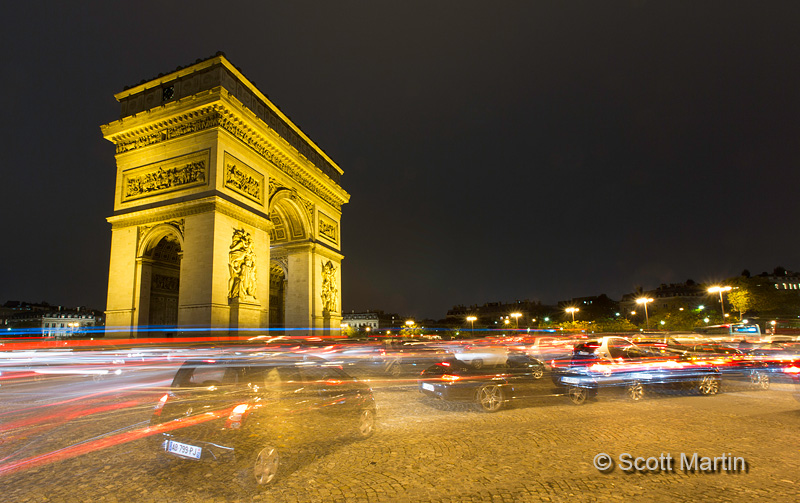
These last two images of the Arc are more classic views, however also required placing oneself into the middle of the traffic to get the desired composition. The first image was taken with a 70-200mm lens from the middle of the Champs Elysées about three blocks from the Arc in order to frame the Arc with the trees and streetlights. It was taken at f/22 to create the starburst effect on the streetlights.
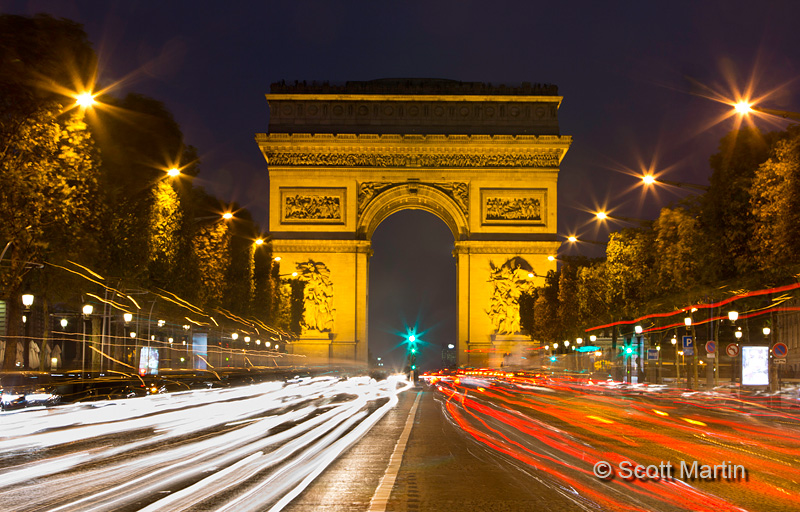
The last shot is similar to the one above however taken on a different street from a vantage point much closer to the Arc using a 16-35mm lens to provide a feel for the curved motion of the vehicles entering and exiting the roundabout.
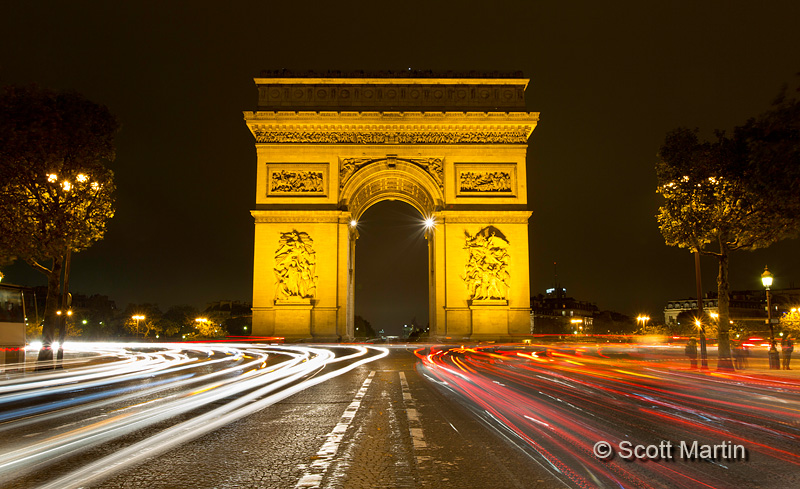
We walked the three miles between the Arc and the Louvre down the Champs Elysées and the following are a few snapshots along the way.
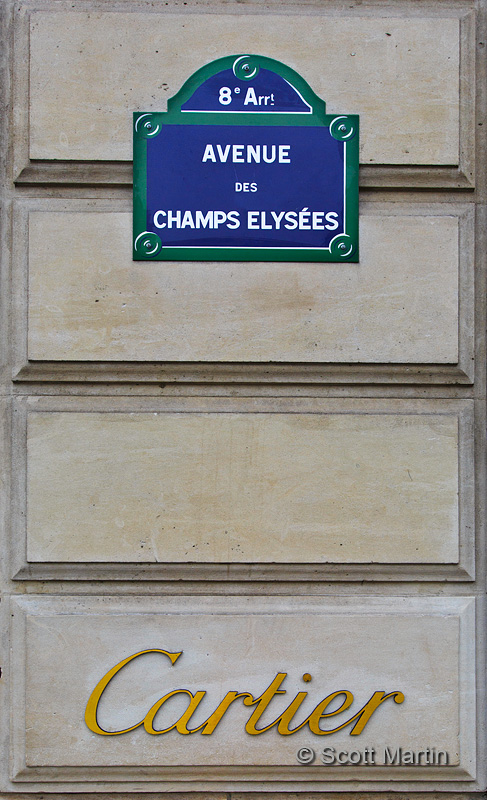
We didn’t buy any jewelry at Cartier, however we did stop at my new favourite shop, LaDuree, the worlds best (and probably most expensive) bakery.
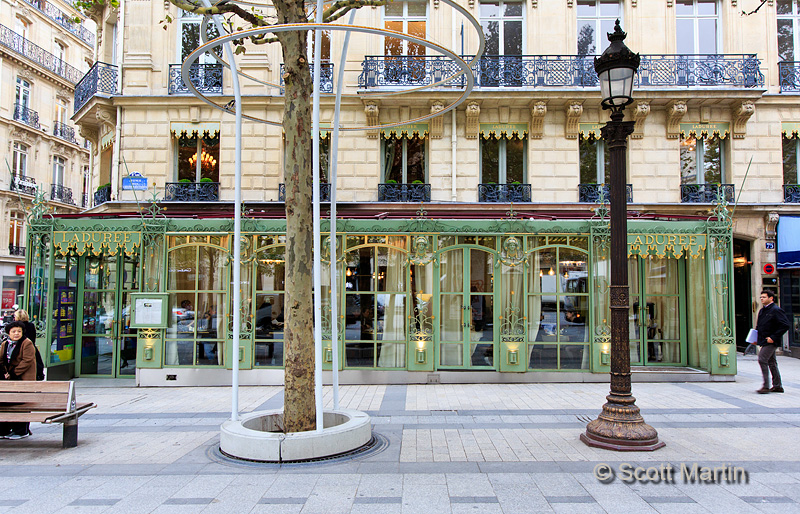
Absolutely spectacular!
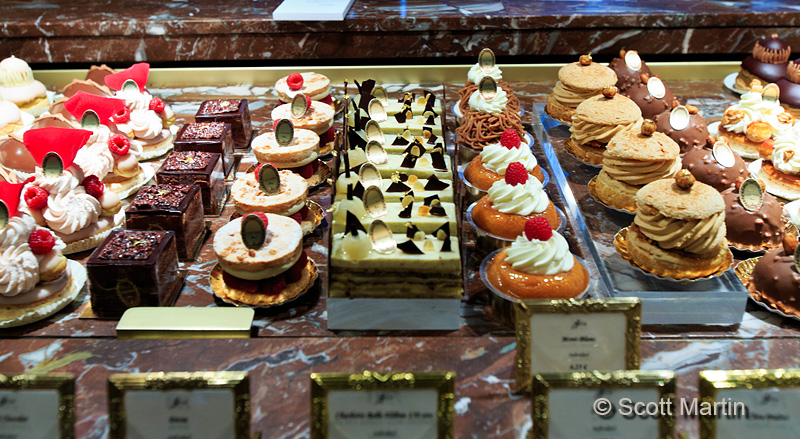
When you think of Louis Vuitton in Canada, you picture a small high end boutique…..in Paris its a department store!
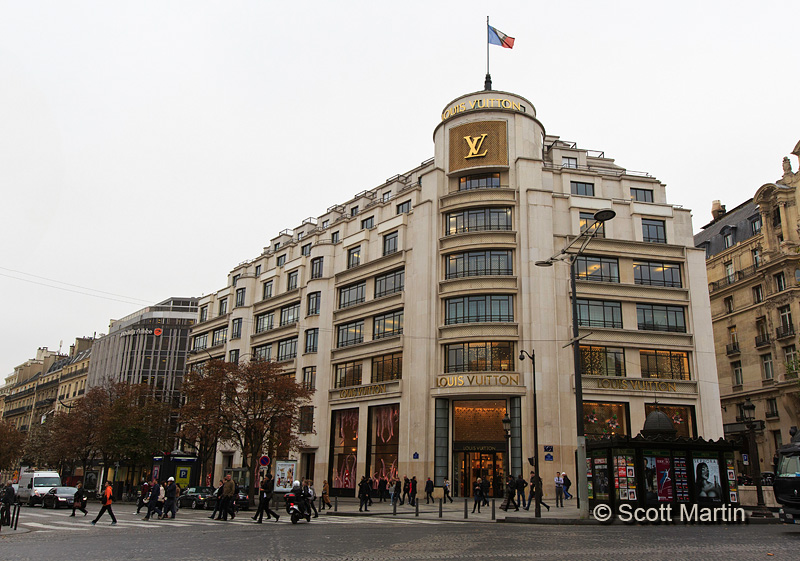
The Champs Elysées ends at the Obelisk of Luxor which stands in the middle of the Place de la Concorde. It first stood in front of the Luxor Temple in Egypt over 3,300 years ago. The 75′ high yellow granite obelisk arrived in Paris on December 21, 1833, exactly 180 years ago today!
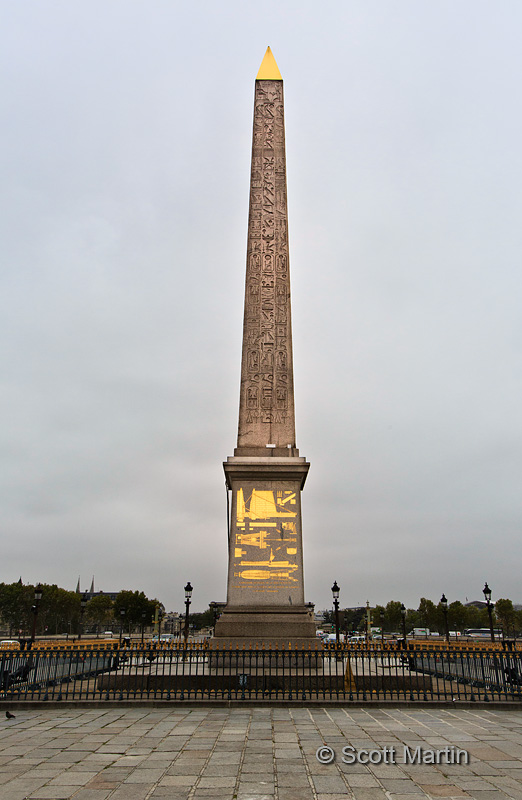
Beyond the obelisk to the east are a number of parks and museums stretching out about a kilometer before arriving at the Louvre.
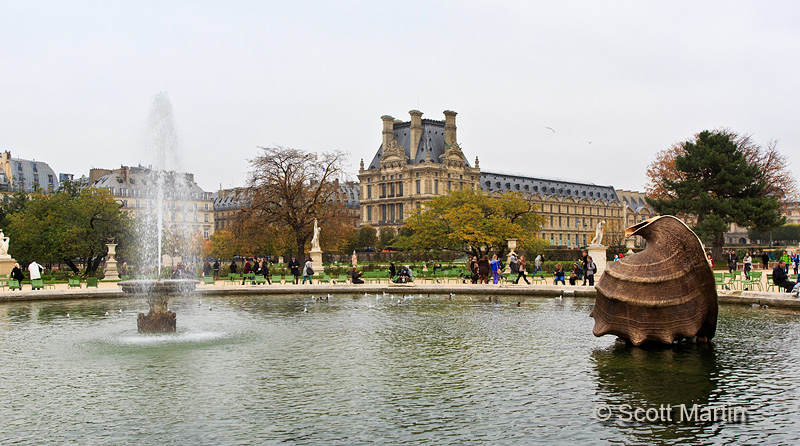
The last park you pass through on the way to the Louvre is Place du Carrousel in the centre of which is the Arc de Triomphe du Carrousel which stands in perfect alignment with the Obelisk Luxor, the Champs Elysées and the Arc de Triomphe in Place du Gaulle almost three miles away. The Carrousel Arc is older and about half the size of the Arc de Triomphe.
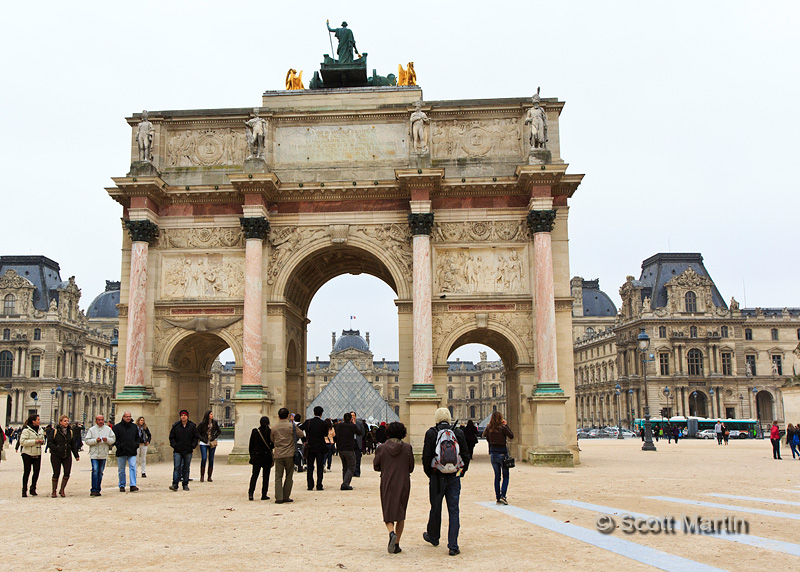
…..and the typical tourist shot 🙂
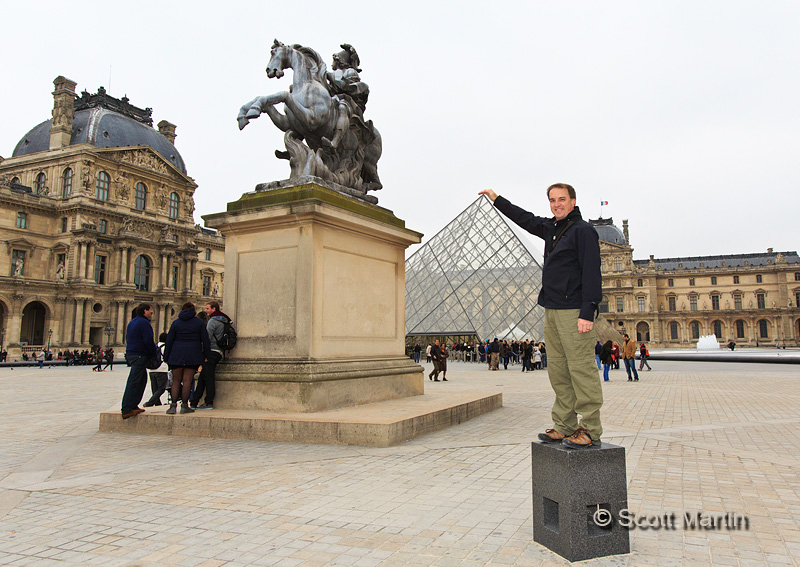
One of the things that surprised me about the Louvre was its sheer size as well as how the modern glass pyramids rise out of the central square yet don’t seem to detract from the old architecture of the museum buildings themselves.
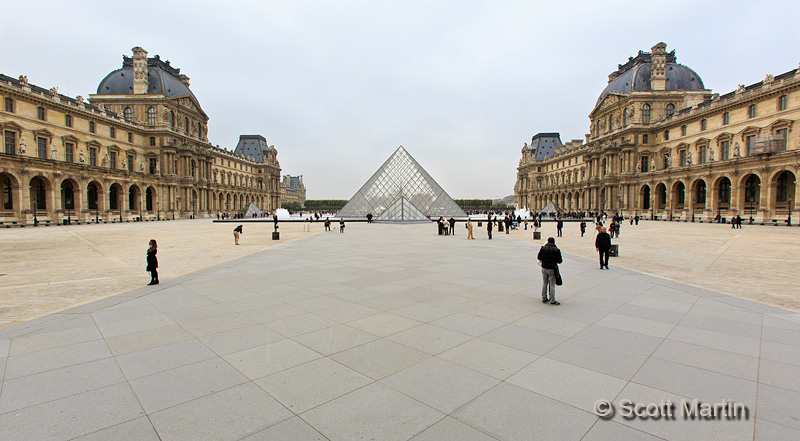
.
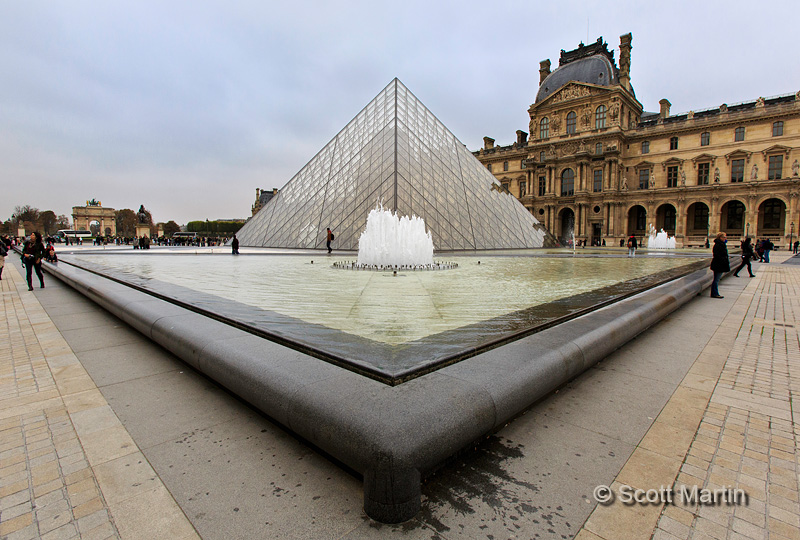
.
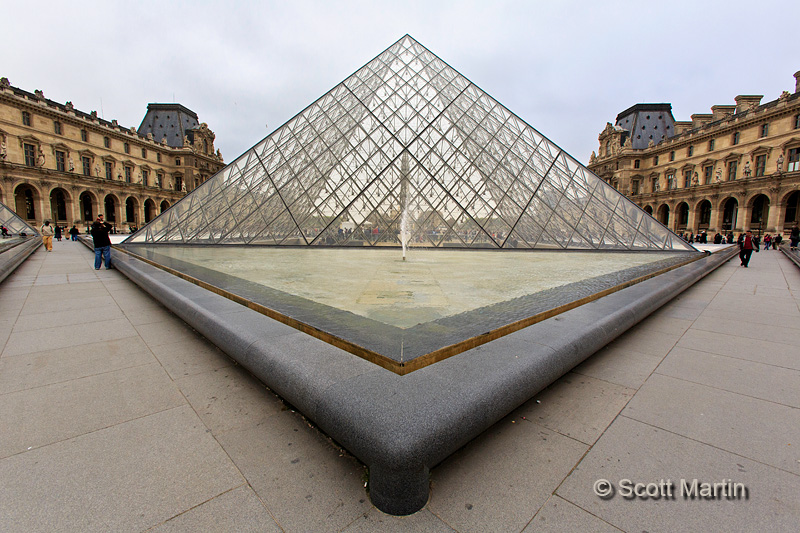
.
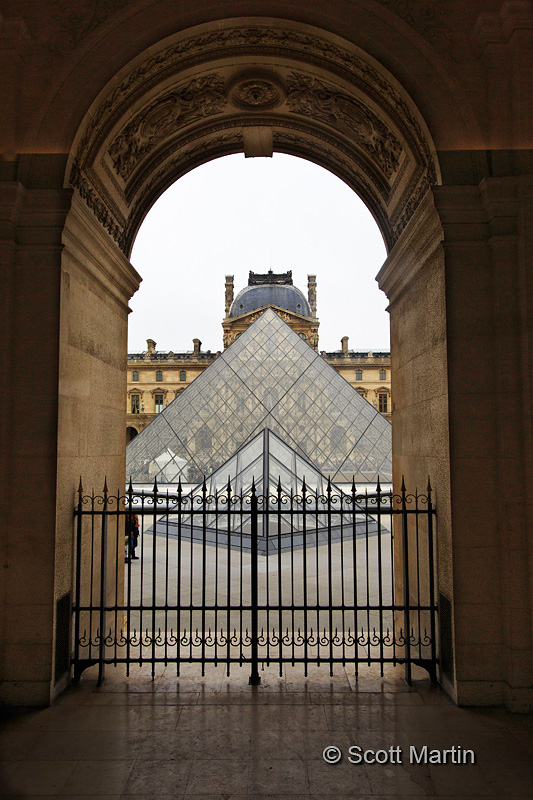
.
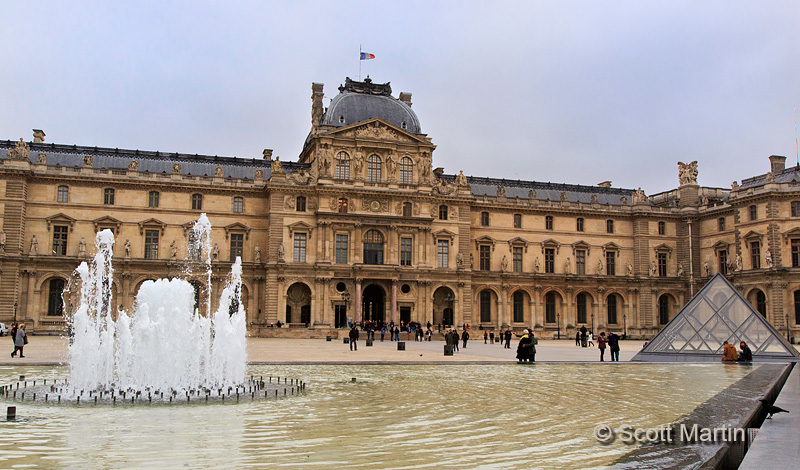
Using my iPhone, I recorded a 360° panorama using an app called Photosynth. Click here to check it out. (Note: The pano works fine on Chrome and Firefox however I did have problems viewing it on Safari)
The main entrance to the Louvre is through the central pyramid and down into a cavernous subterranean lobby accessed by a large circular stairway.
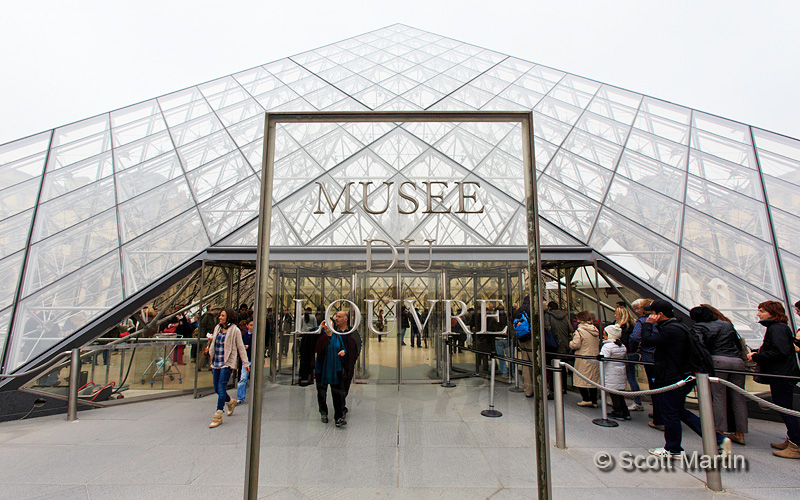
.
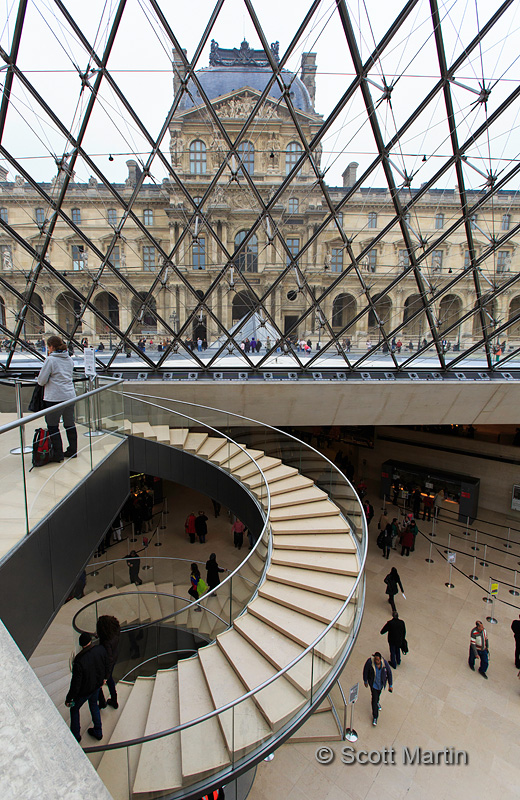
The next image is interesting for the photography enthusiast. It is an in-camera ±3 stop HDR that is processed in the 5D MkIII and saved as a single image. You can customize the exposure settings as well as how the images are processed. Once set up, the camera takes three different exposures of the same scene and then merges them into one image which it saves before deleting the three original images. HDR is an acronym for High Dynamic Range , which refers to scenes where the light intensity within the frame exceeds the ability of the camera to correctly expose the image with one shot. In the image below I metered on the central yellow pillar and set the camera to take one shot at that exposure plus one three stops over-exposed (to properly record the dark areas in the lobby) and one three stops under-exposed (to properly record the bright sky). Putting those three shots together resulted in the shot below. The amazing thing was that all of this happened with one trip of the shutter. Photographers have been doing HDR shots for years, however they always took lots of time ‘developing’ them on the computer afterwards.
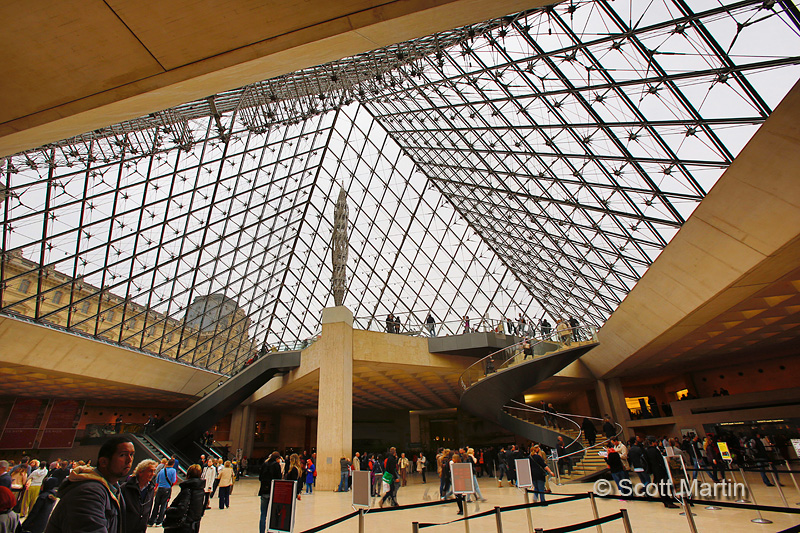
Wandering through the seemingly endless maze of hallways and galleries within the Louvre was fascinating for Deb & me, even though neither one of us grew up with an appreciation for the arts. I could include many images however will pare them down to arguably the two most famous pieces found within the walls of the Louvre. The Mona Lisa and Venus de Milo.
The Mona Lisa was painted on a white poplar panel around 1506 by the Italian painter Leonardo da Vinci. Although not small, the 30×21″ painting is not as large as one expects when viewing it for the first time.
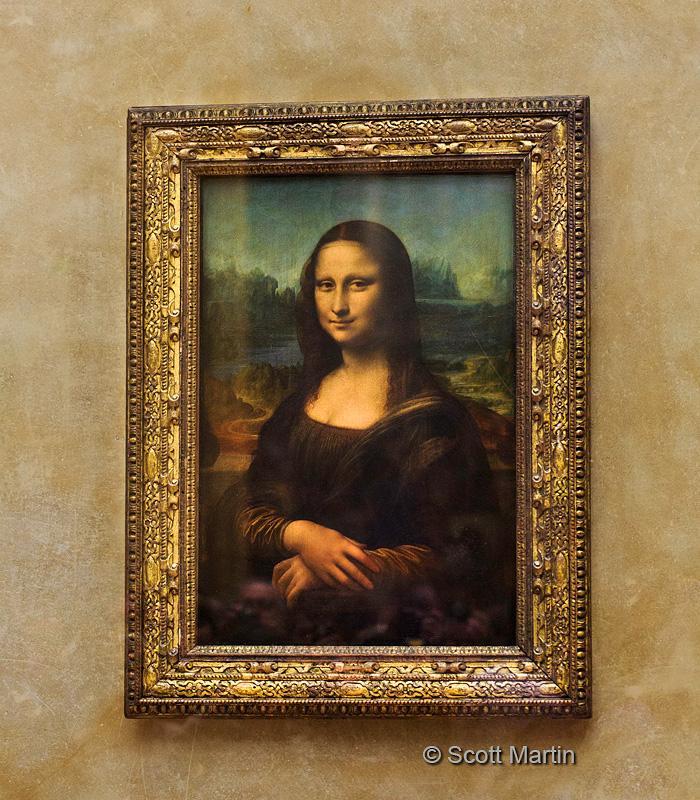
Venus de Milo, or more correctly Aphrodite of Milos, is a 6’8″ white marble statue carved sometime between 130-100 BC by Alexandros of Antioch. Its larger than life size and folk-lore suggest that it depicts Aphrodite, the Greek goddess of love & beauty, known to the Romans as Venus.
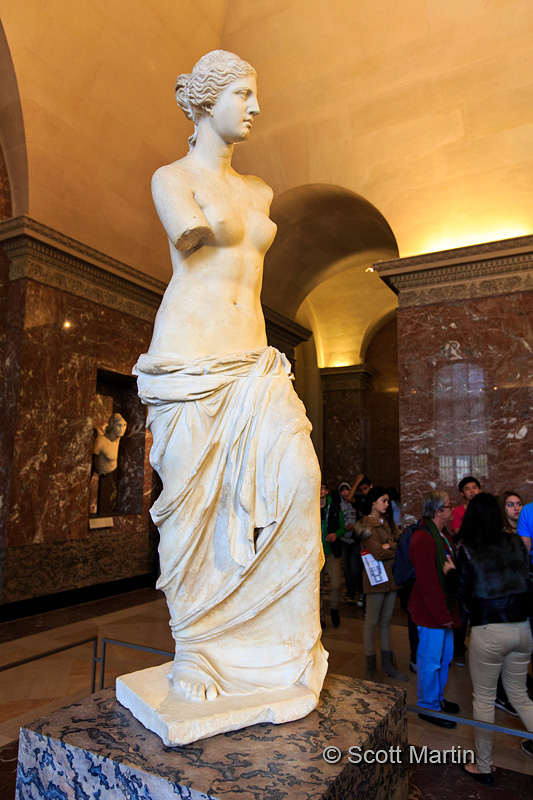
After finishing our tour of the Louvre we crossed over to the left bank of the River Seine and headed towards Notre Dame and the Eiffel Tower which will be the subject of the next blog post.
A very Merry Christmas to all who stop by the blog and I look forward to keeping in touch with you in 2014.
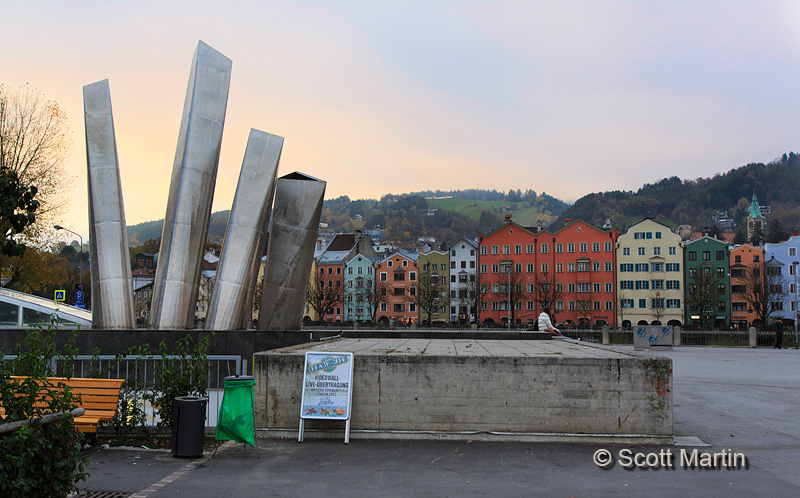
by Scott Martin Photography | Nov 23, 2013 | Blog, Cityscapes, Educational, Landscapes, Travel
After one last Vaporetto ride along the Grand Canal, we arrived back at the Venice Car Park where we loaded up our luggage and headed North for the 400 km drive to Innsbruck, Austria. The sun was descending below the mountains when we arrived at our hotel in the Old Town section of Innsbruck. We walked to the Town Square where we enjoyed some fine Austrian cuisine after which we wandered around recording some memories of this city that hosted the 1964 and 1976 Winter Olympics.
The remnants of the Olympic flame monument in the park where the Olympic medals were awarded almost fifty years ago.

The Goldenes Dachl, or Golden Roof is Innsbruck’s most famous landmark and is a three-story balcony built in the fifteenth century as a palace for Emperor Maximilian I. The balcony was their private perch for watching the festivals that took place in the town square below. The golden roof is made from 2,738 gold-plated copper tiles and they really do serve as the focal point of the square.
The Goldenes Dachl at dusk.
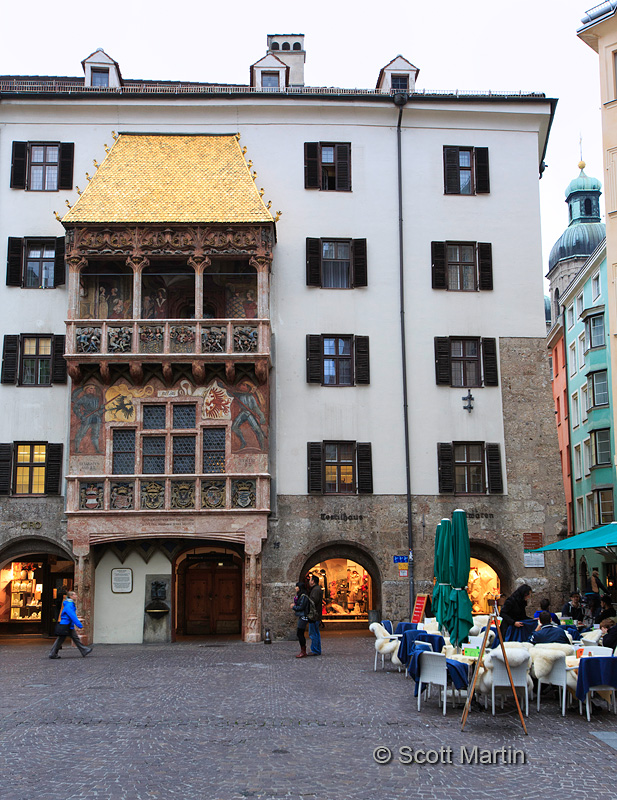
…and after dark.
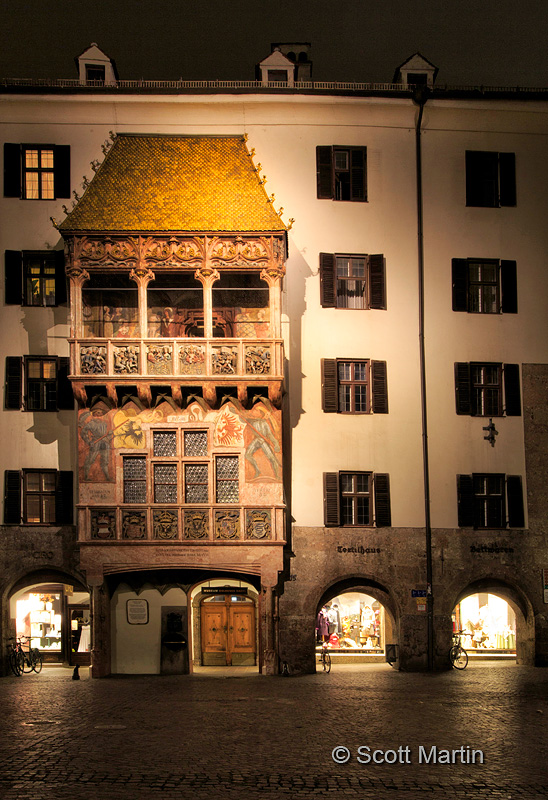
The town square in Old Town is a wonderful area that has remained relatively unchanged for the last 500 years. There are many cafe’s around the perimeter of the square that are designed for warmth in the colder weather, right down to the sheep skin throw blankets on every chair.
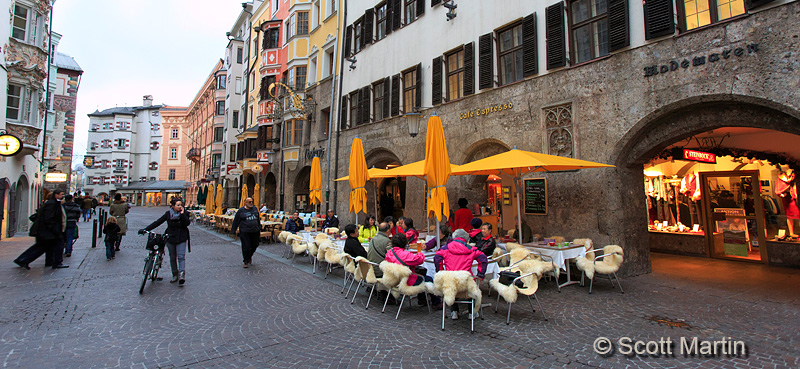
The Innsbruck Cathedral or Cathedral of St. James, a Baroque Cathedral built between 1717-1724.
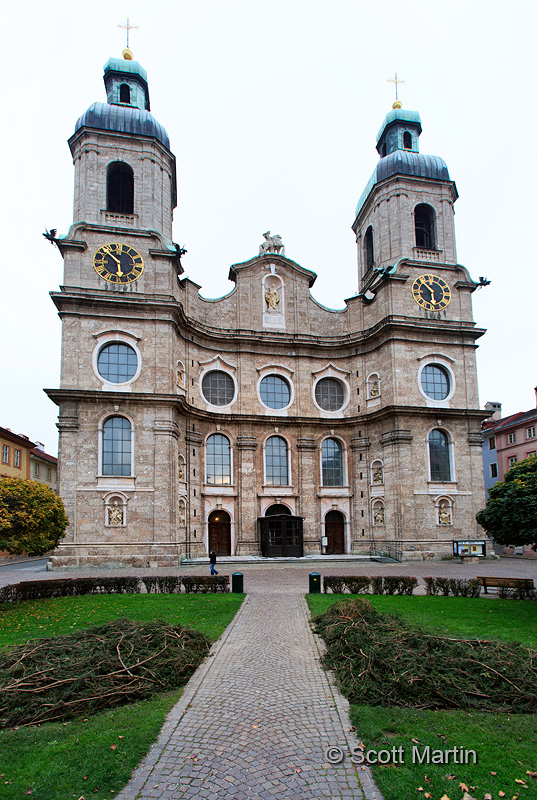
Helblinghaus dates back to the fifteenth century and was constructed as a town house. The ornate detail of the facade is in keeping with its neighbour with the golden roof!
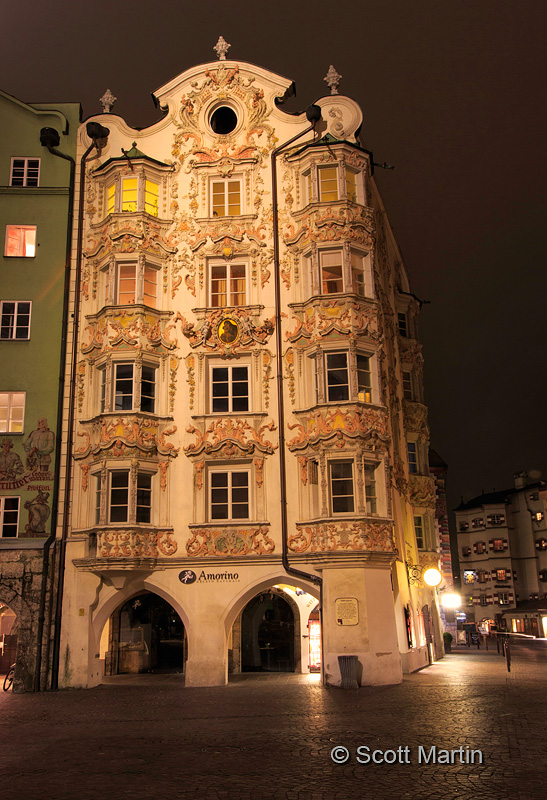
This last image from Innsbruck is the City Tower, another focal point of the Old Town district of Innsbruck.
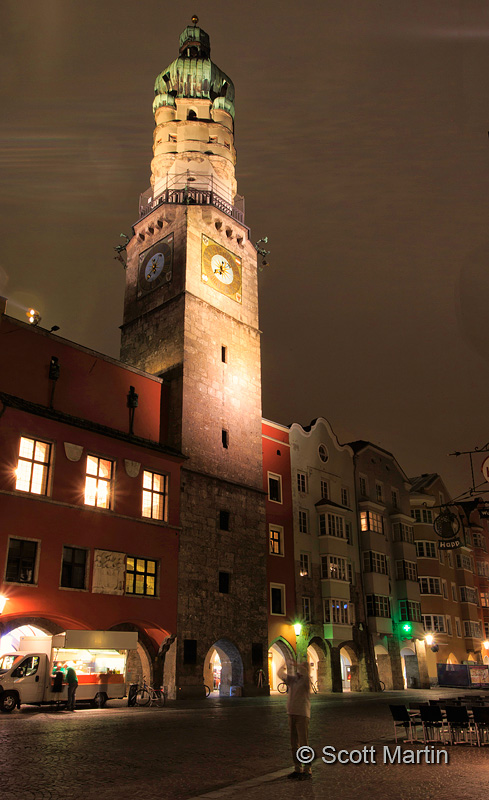
Following our very brief one night stay in Innsbruck we headed west, through Austria and Switzerland to our next stop which was Geneva, nestled on the edge of Lake Geneva on the Swiss/French border, some 580 km from Innsbruck. This day was designed for us to enjoy driving through the Alps and seeing one of the most picturesque mountain ranges in the world. We did enjoy the day however did not see a single mountain thanks to a very low cloud ceiling that day that extended the entire distance between Innsbruck and Geneva. Hopefully we will fare better the next time we make the trek!
Geneva is a fabulous city and it would have been nice to spend more time there, however we arrived late in the day and were on the road early the next morning heading towards Paris. The metropolitan Geneva area has a population of over one million people and has the third highest quality of life of any city in the world (after Vienna and Zürich). It boasts more international organization headquarters than any other city in the world and not surprisingly is rated as the third most expensive place in the world in which to live. We instinctively knew this because the burgers and fries at the restaurant where we had diner were thirty eight Euros!
For our evening in Geneva we headed down town to the old centre of Geneva where the University of Geneva is located. Adjacent to the university are some of the city’s cultural landmarks. Below is the Geneva Theatre.
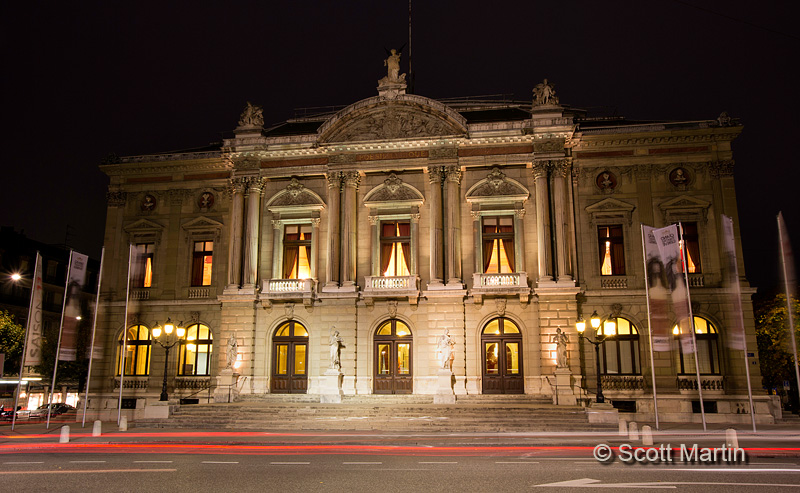
And a little different perspective. Unfortunately it was impossible to include the fountain and not the light standard.
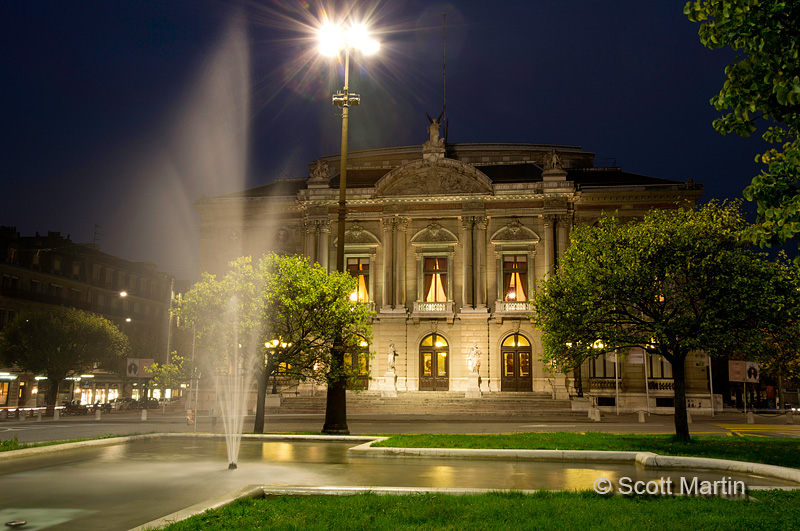
Next to the theatre was the museum , again with an annoying light standard. If you look closely you will note the streetlight is behind the statue of the horse & rider, which would typically result in the statue being underexposed as it was completely back lit. To solve this problem, during the thirty second exposure I grabbed the flash and ran up to the statue base and fired the flash at the horse & rider about six times while I made sure to never stop moving (so I didn’t show up in the picture). This technique is know as light painting and is a common practice in night photography. It takes a bit of practice but is not really that difficult….just don’t stop moving!
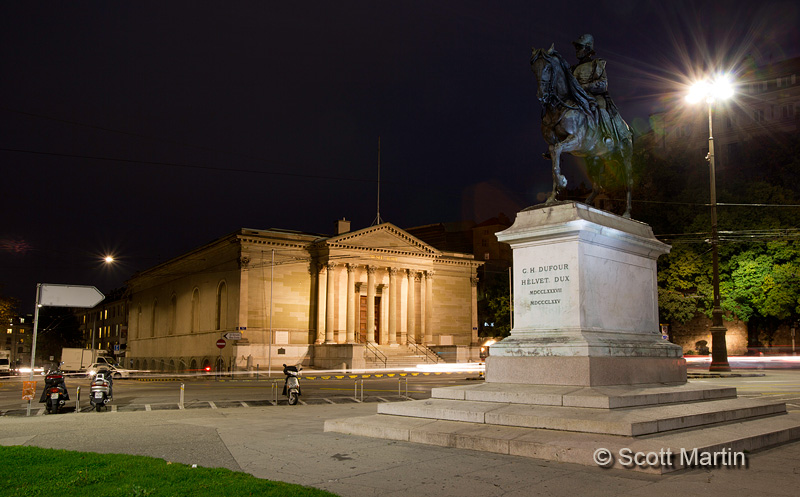
The University of Geneva is a sprawling campus in the heart of the old city. On its park like setting there are many academic buildings, lecture halls, dormitories and libraries however my favourite was this little cafe with bigger than life checker and chess boards out front for anyone to play.
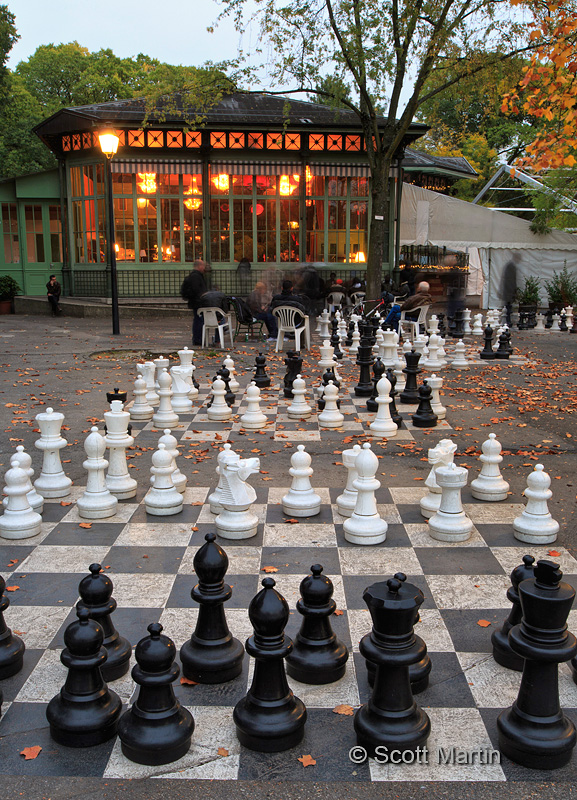
The reason we visited the university was to see Reformation Wall which is a 100 metre long monument built into the side of the old wall of the city of Geneva. Reformers Wall was constructed in 1909 to commemorate the 350th anniversary of the founding of the University of Geneva by John Calvin on June 5, 1559. The wall features ten prominent theologians of the Reformation period in the mid fourteenth century. Although John Calvin is noted as the founder of the university, he is best know for his role in the Protestant Reformation initiated by Martin Luther who nailed his Ninety Five Theses on the door of his church on October 31, 1517, a document that ‘protested’ (hense Protestant) the theology, doctrine and structure of the Roman Catholic Church. In 1536 John Calvin published his opus “Institutes of the Christian Religion”.
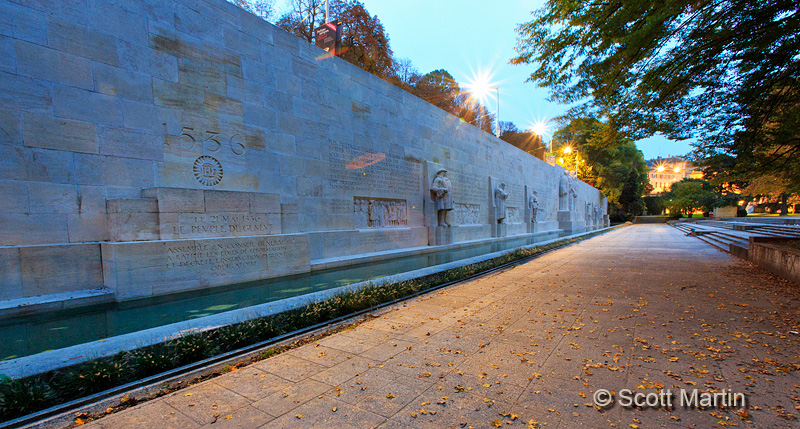
In the centre of Reformation Wall are statues of (from left to right) William Farel, John Calvin, Theodore Beza and John Knox that stand 16.5′ high.
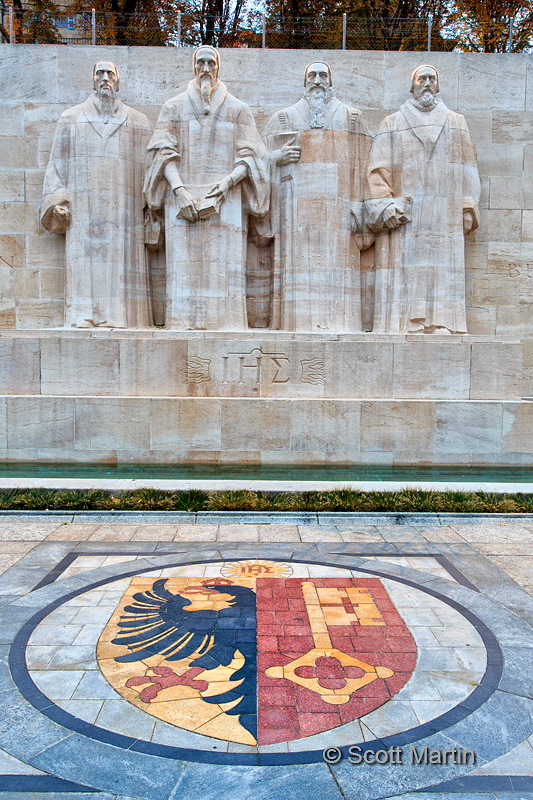
Although the above image may look like it was taken on a dull day, it was really taken in the virtual dark and is a 25 second time exposure.
I trust you have enjoyed these few images from Innsbruck and Geneva. It was unfortunate that we couldn’t spend more time exploring these two cities but it is impossible to fit everything into one trip! After one night in Geneva we headed to Paris where we spent almost three days and took enough photographs to supply the material for more than one blog post.
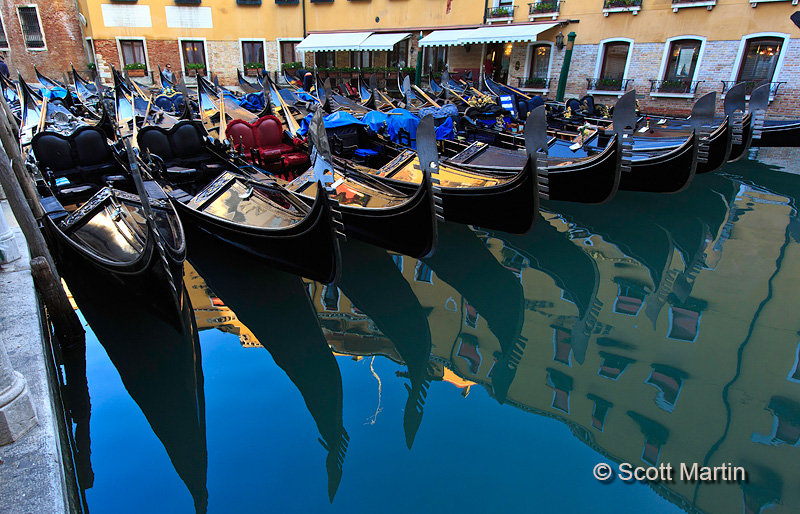
by Scott Martin Photography | Nov 16, 2013 | Blog, Cityscapes, Landscapes, Travel
This last blog post from Venice will highlight some of the more artistic, iconic views of the city that I trust will show the wide-ranging photo opportunities that exist in The City of Light. Venice has many nick names and the one I’ve chosen today serves to highlight the fact that lighting is the most important factor that must be considered when talking any picture. Being at the right place with bad light means you are there at the wrong time. Deb and I spent our first half day in Venice with a professional photographer, Marco Secchi, and our time with him was invaluable. Marco showed us the sights of Venice, had us at the right places at the right time when the light was perfect and helped us plan the rest of our time in Venice allowing us to find the best places to fully experience the city in the almost three days we spent there. Most of the images in today’s post were taken while we were with Marco. If you ever plan to be in Venice, you need to arrange your travel plans around Marco’s schedule!
Some of the 450 gondolas that ply the canals.

These next two images illustrate how two very similar pictures can create different results based on a slight change in composition. I probably took a dozen or more shots of this scene, and am still not sure which of these two is the best result. Always take time when you find an interesting scene to explore many different angles and compositions in order to arrive at the best result.
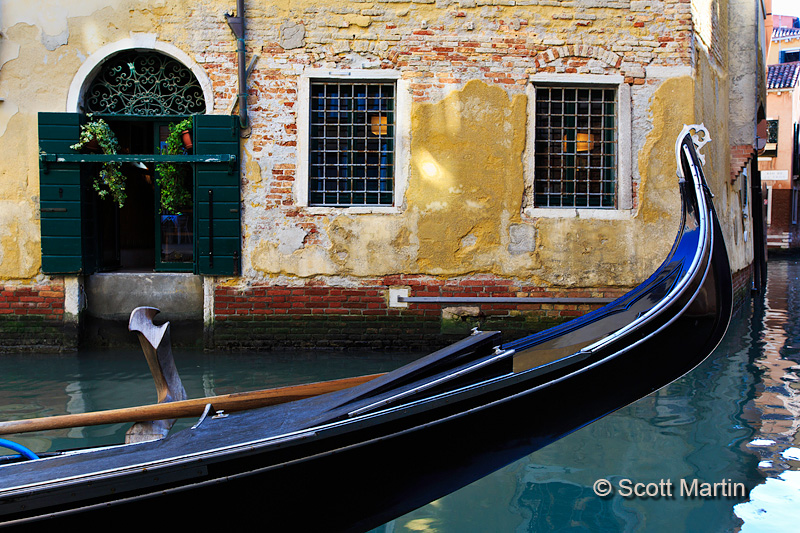
.
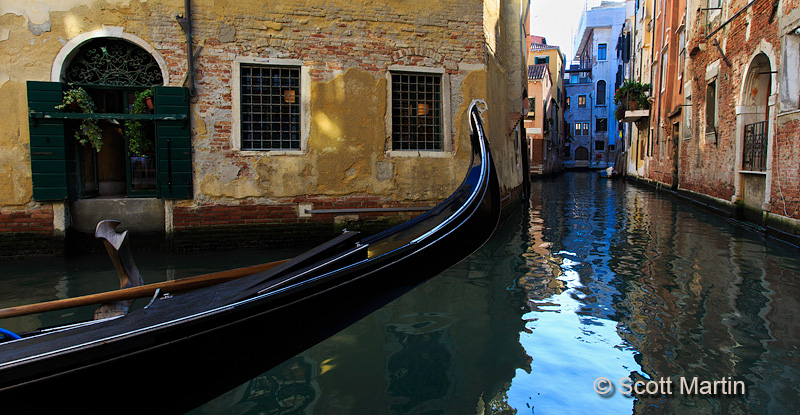
Sometimes when the sun is in the absolutely the wrong place for a photography, you can be creative and make it work in your favour. Thanks to Marco for teaching me to think ‘outside of the box’ and take a shot like this one.
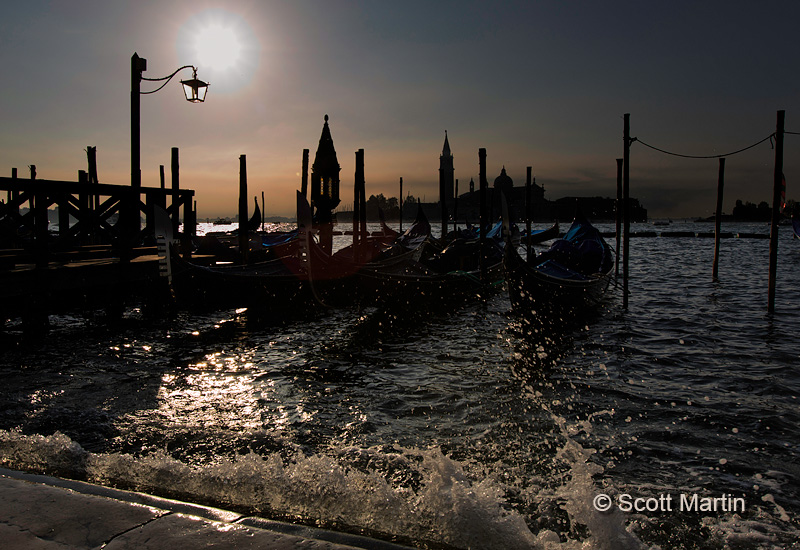
The Bridge of Sighs taken using the old white marble rails of the bridge as a frame.
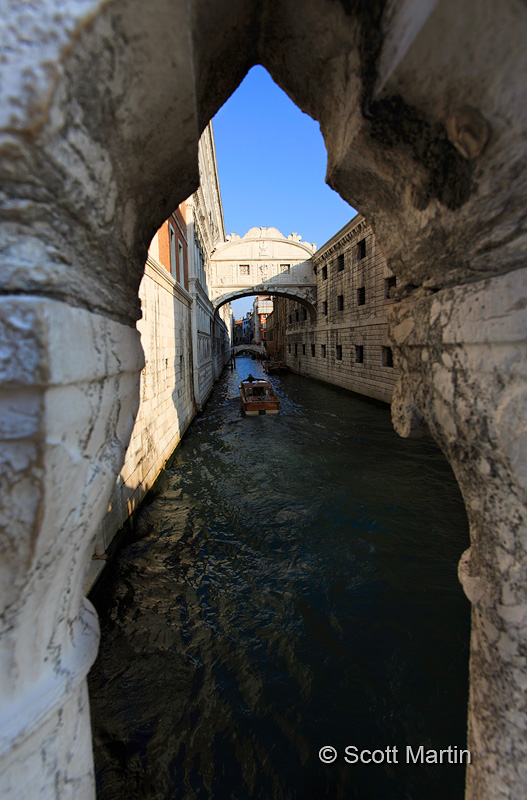
And a more traditional view.
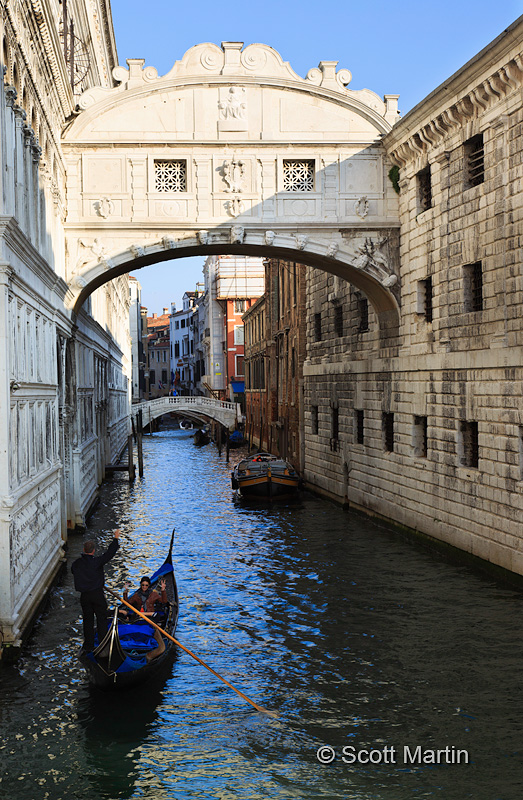
The ornate veranda columns of Doge’s Palace and the interesting shadows they cast.
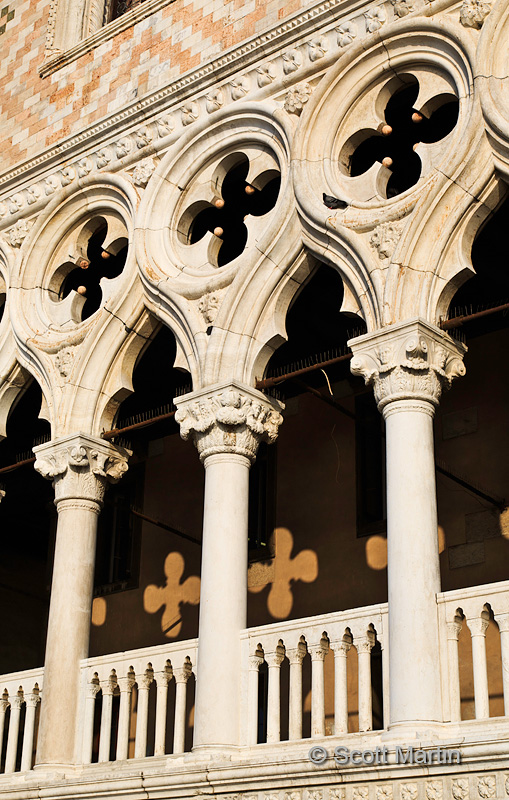
A charming Venetian Street.
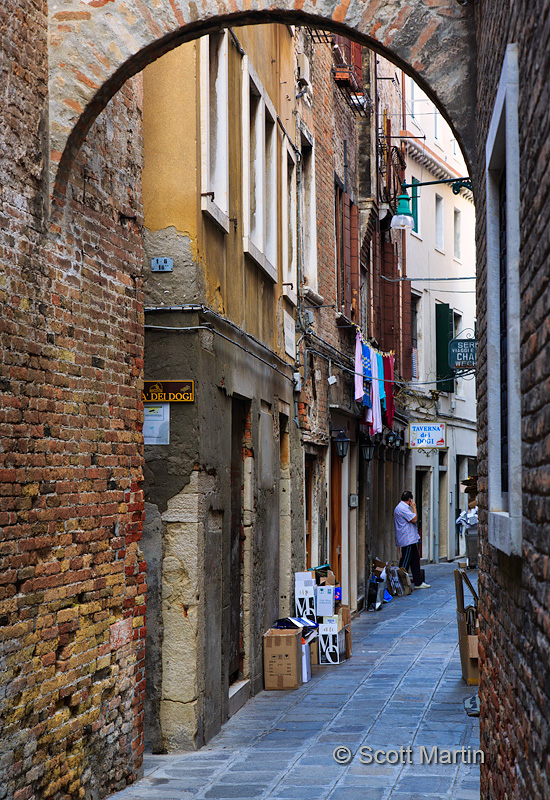
The next two shots are of the crypt below San Zaccaria, a church named after Zacharias, the father of John the Baptist. Zacharius’ body is on view in the church. The crypt below the church was flooded, however by climbing down a few old wooden stairs it was possible to get some pics. Unfortunately I did not have a tripod with me at the time so these shots are taken hand-held, ISO 4000 f/4 at 1/4 of a second.
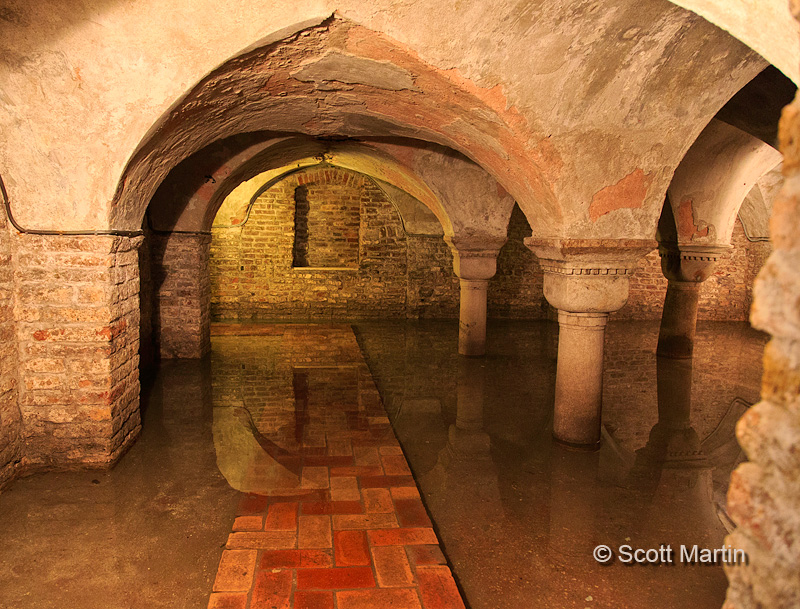
.
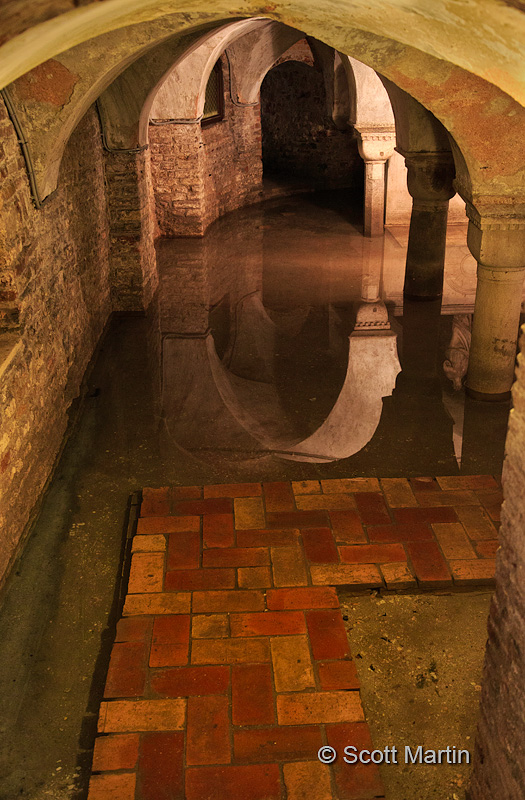
A gondolier navigating the narrow canals. No three point turns here!
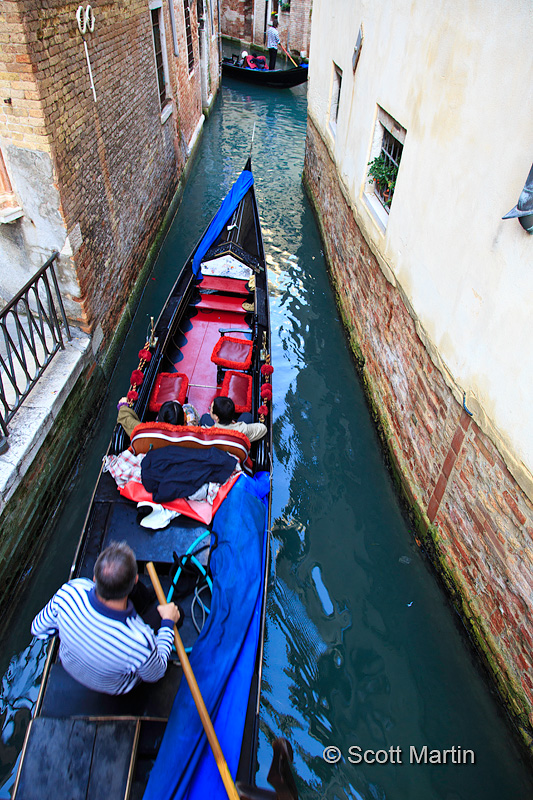
You could spend days simply photographing the windows and doors of Venice. This next image demonstrates how over the centuries nothing remains square in the city that is slowly sinking into the lagoon on which it is built.
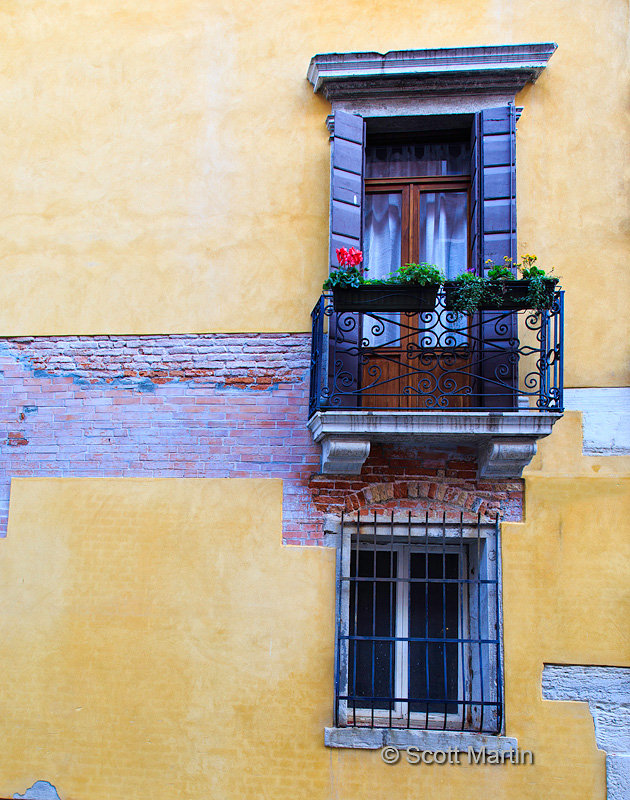
This next shot has all the quintessential components that make it easily recognizable as being from Venice.
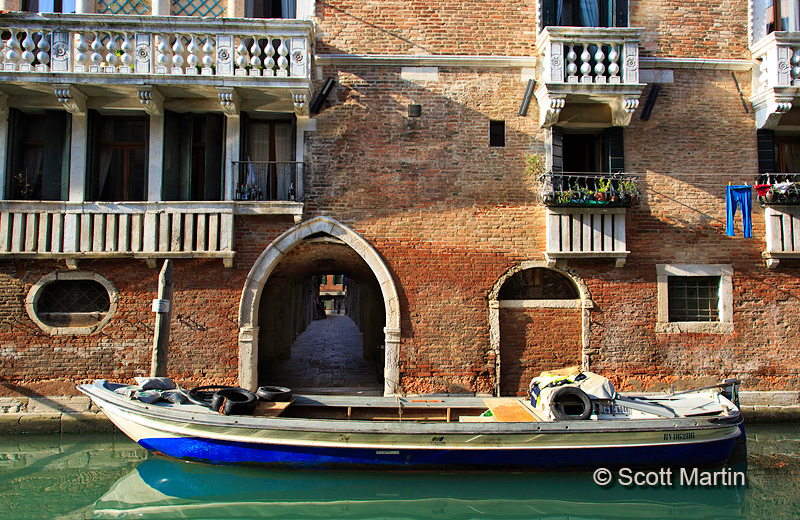
It’s great for a photographer when the colour of the clothes on the line match the boat 🙂
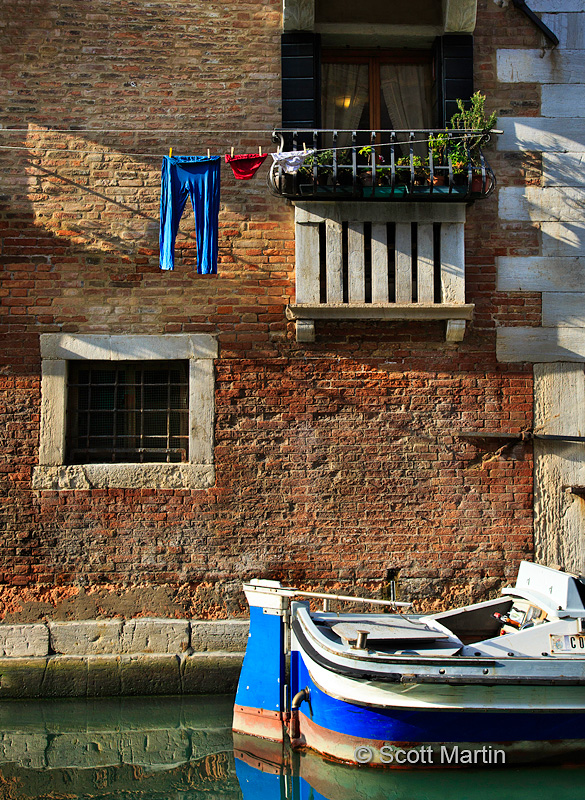
.
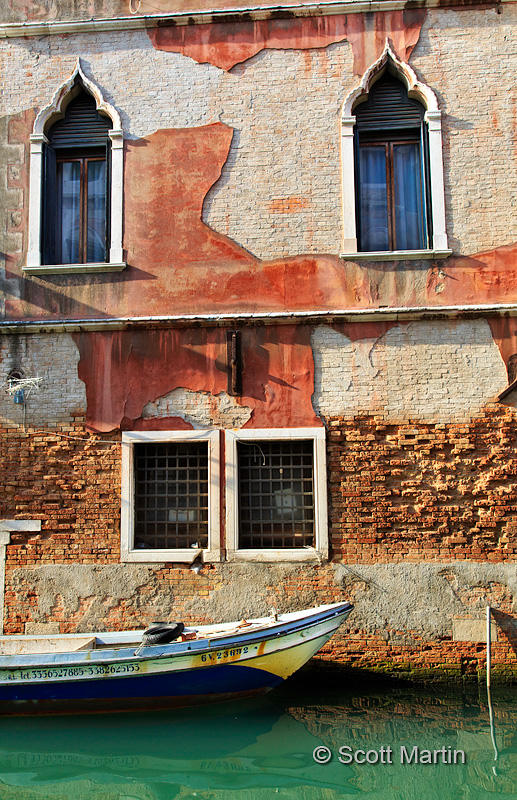
The long history and rich tradition of the gondolier is evident in the ornate detail of their gondolas.
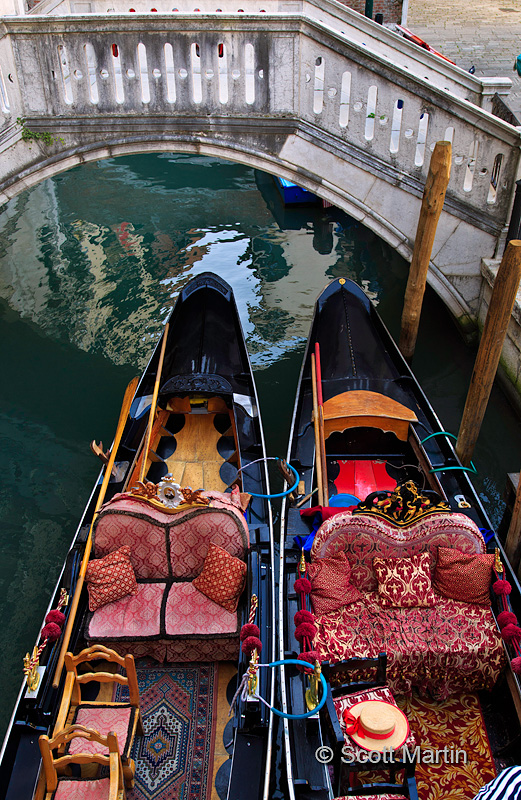
.
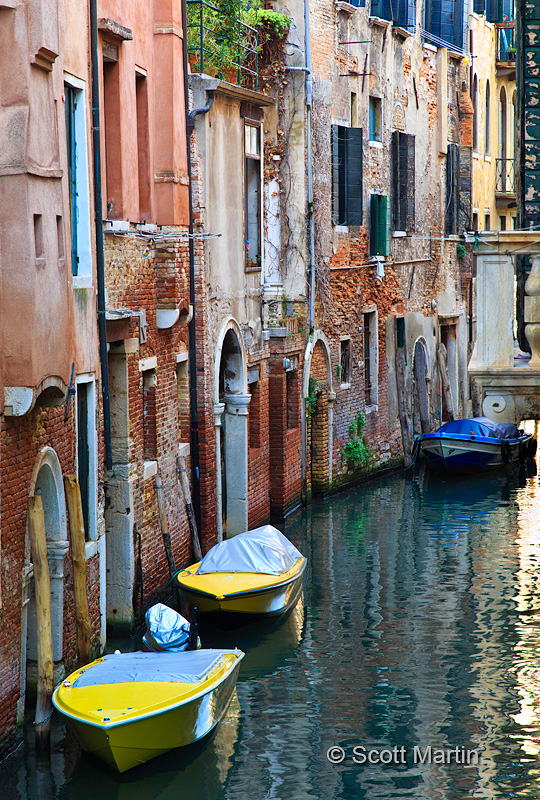
The Acqua Alta Bookshop was the most interesting and unique bookshop we have ever been in. You have to see it to believe it and we were so happy that Marco took us by for a visit.
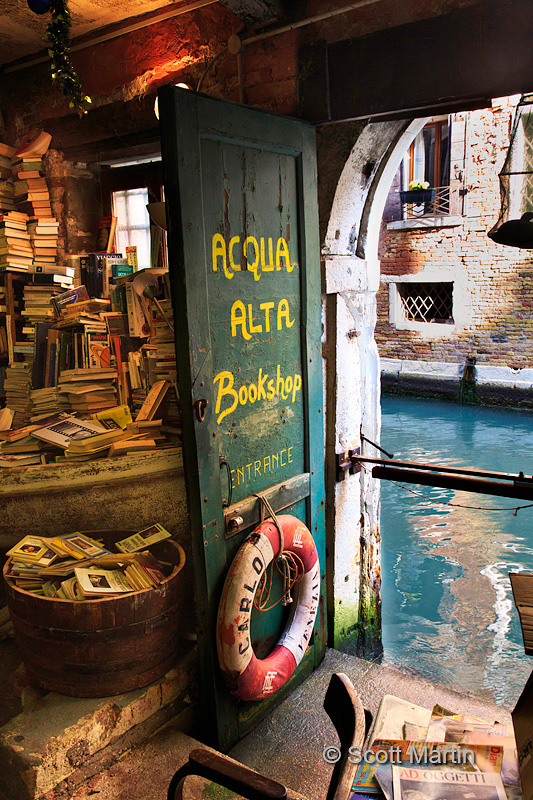
Unfortunately graffiti is a problem in Venice (as in most cities) so I’ve purposely included in this next shot of a well.
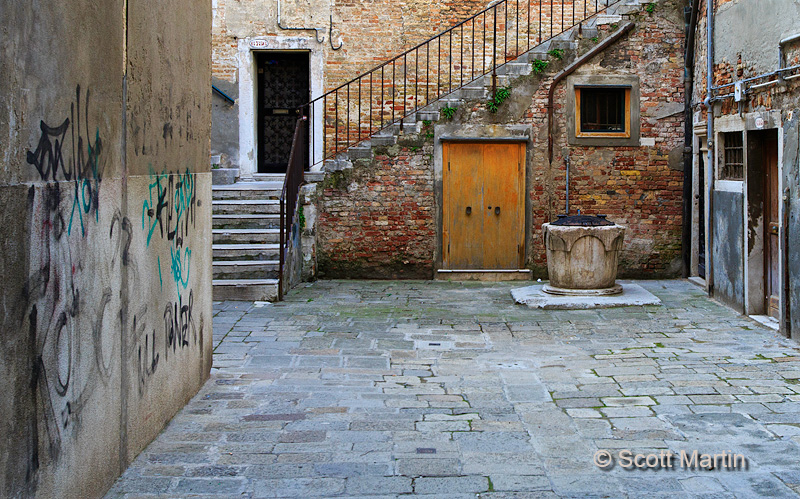
Here is an image of the same well composed to exclude the graffiti and create a completely different result.
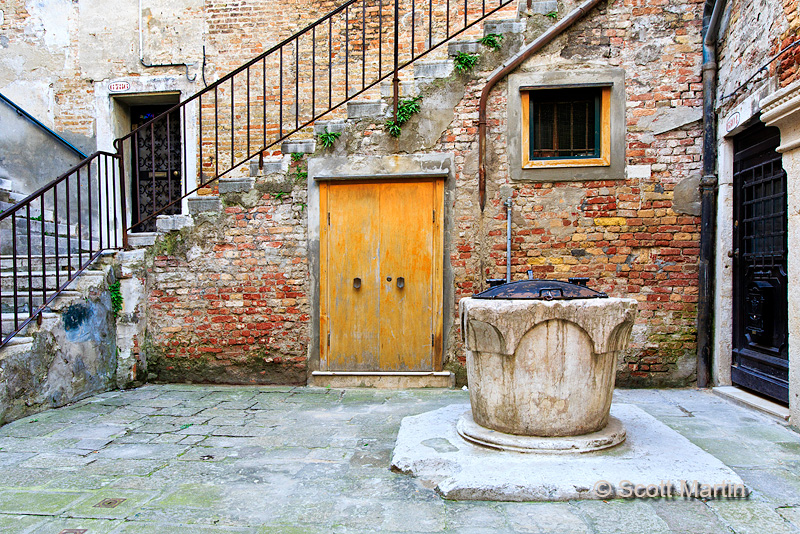
And for something totally different, a close up of red and green peppers at the market.
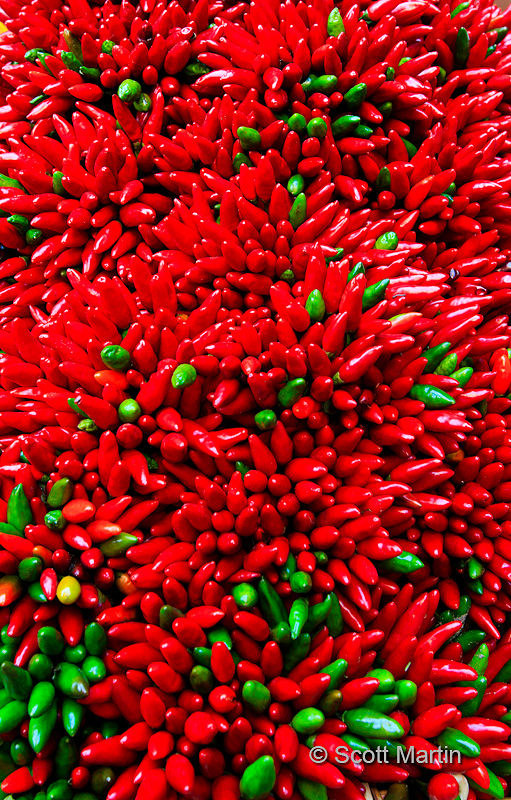
Every archway leads to a wonderful view.
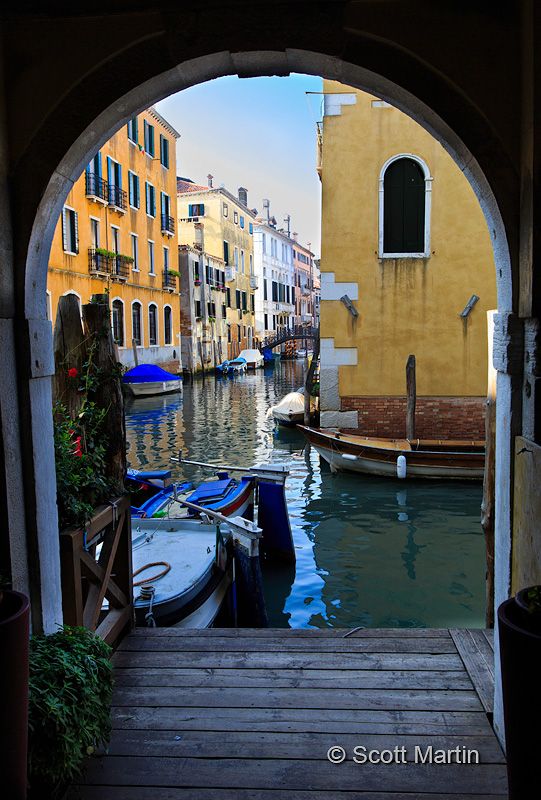
Although you’ve seen this final image before, it represents the sun going down on our time in Venice. I trust you’ve enjoyed this three part series from Venice and these photographs have either brought back fond memories of a past visit or perhaps persuaded you to add this beautiful city to your list of places to visit.
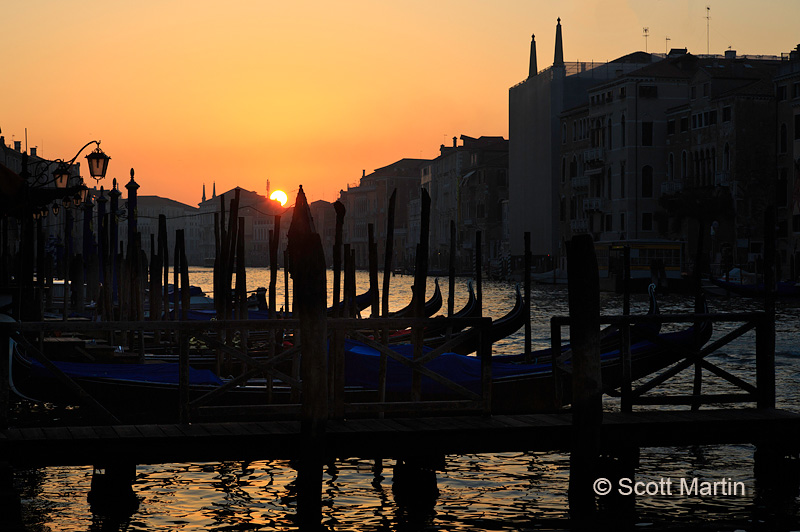
All of the images from Venice can be seen in the Venice Gallery
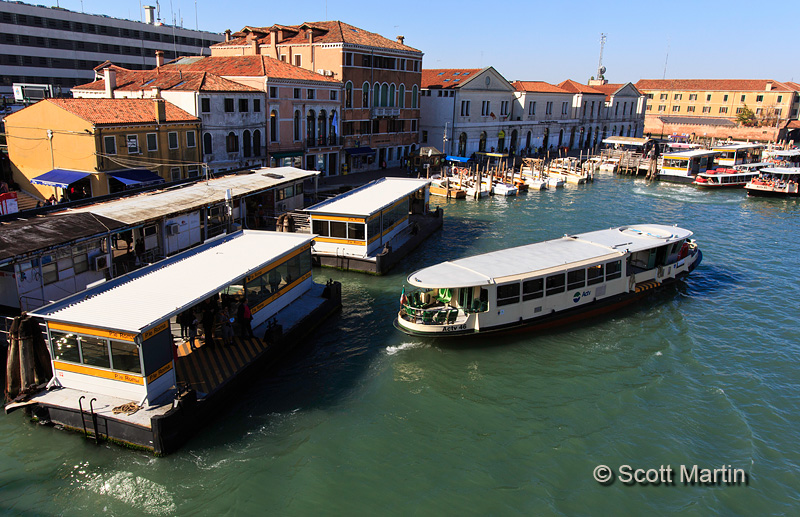
by Scott Martin Photography | Nov 9, 2013 | Blog, Cityscapes, Landscapes, Travel
Venice is an incredible city that is one of those “bucket list” places to visit. The Floating City as it is often referred to was formed around the sixth century as the Roman Empire’s power base was diminishing and attacks from the Lombards and Huns caused the people to form the defensive stronghold that became Venice, protected from easy attack by the lagoon that separated it from the mainland. The first Doge of Venice (most senior elected magistrate, elected for life) was elected around 700 AD and a continuous rule of Doge’s lasted for the next 1,000 years.
The entire city of Venice is a World Heritage Site and although in 1500 it was one of the most populous cities in the world by the end of WWII the population was 175,000 and in 2010 the population dipped below 60,000 which is less than the average number of tourists who visit the island city every day. The declining population is likely due to the very high cost of living, ironically created by the volume of tourists, causing many native Venetians to relocate to the mainland.
Arriving in Venice by car, you cross via a bridge/causeway, continue past the docks where the cruise ships rest and arrive at a multi-level parking garage where you gladly leave your car, grab your luggage, and head for the entrance of the Grand Canal where any manner of water transportation awaits. We chose the Vaporetto, which can be thought of as a water bus. This pic below shows the first Vaporetto stop at the mouth of the Grand Canal with the parking garage in the back ground.

The image above was taken from the apex of the Calatrava Bridge, which is pictured below. This bridge is one of only four that span the Grand Canal and was completed in 2008 making it the newest bridge in Venice. The Calatrava Bridge is a bit controversial in that it is a stylistically modern design, constructed of steel and glass seems esthetically disconnected from rest of the city, however it is the last ‘modern’ sight you will see until returning to your car.
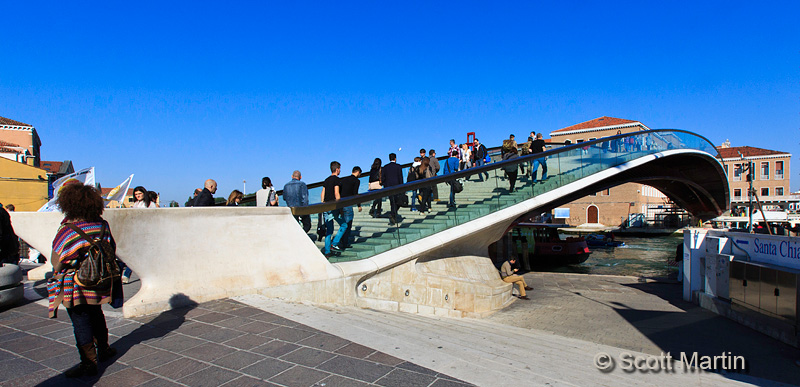
Calatrava Bridge
From the same vantage point atop the bridge but looking down the canal you get your first feel of Venice.
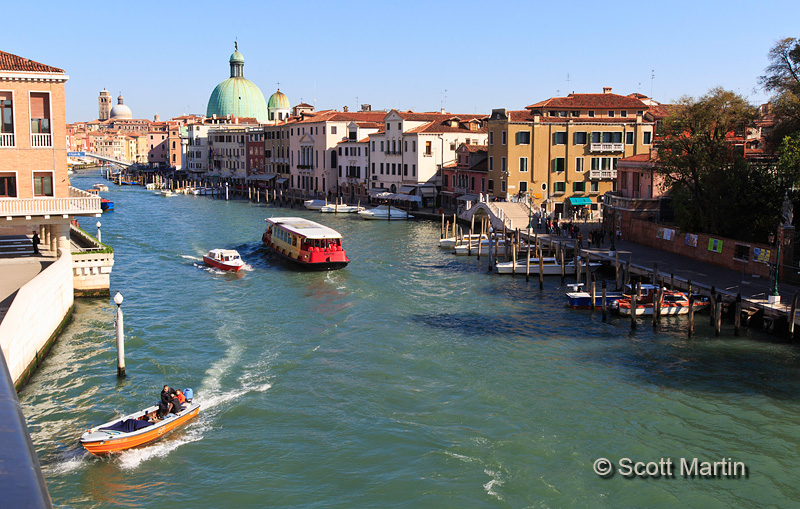
.
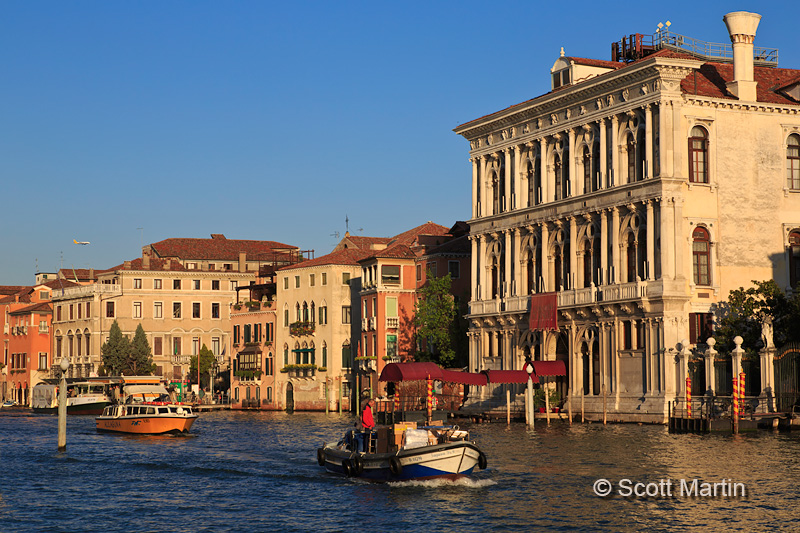
.
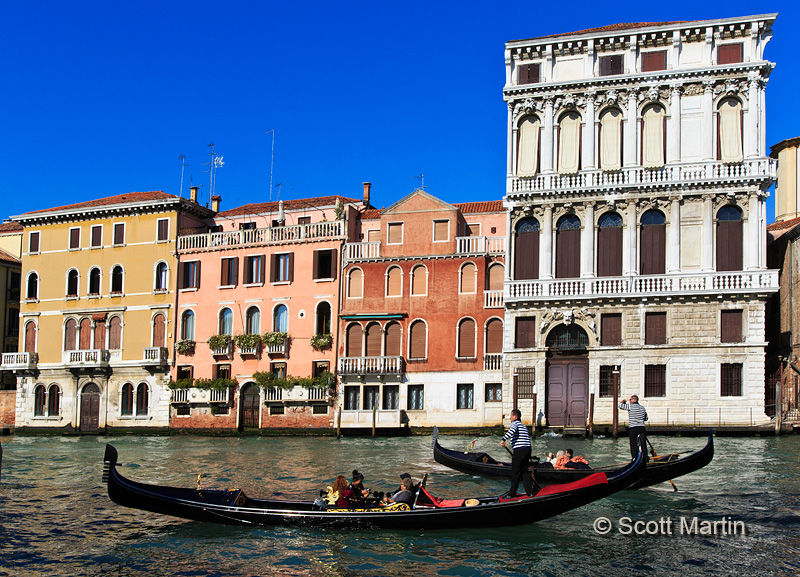
Although the Calatrava Bridge is the youngest and most controversial of the four bridges that span the Grand Canal, the Rialto Bridge is the oldest,most famous and most photographed of the quartet. The first iteration of what is now the Rialto Bridge was a pontoon bridge constructed in 1181 and replaced with a timber structure in 1255. The present stone version was completed in 1591. The Rialto Bridge and the gondolas that ply the waters beneath it are two of the most iconic fixtures of Venice. Trying to include both effectively in the same frame was a bit of a challenge but I hope we succeeded.
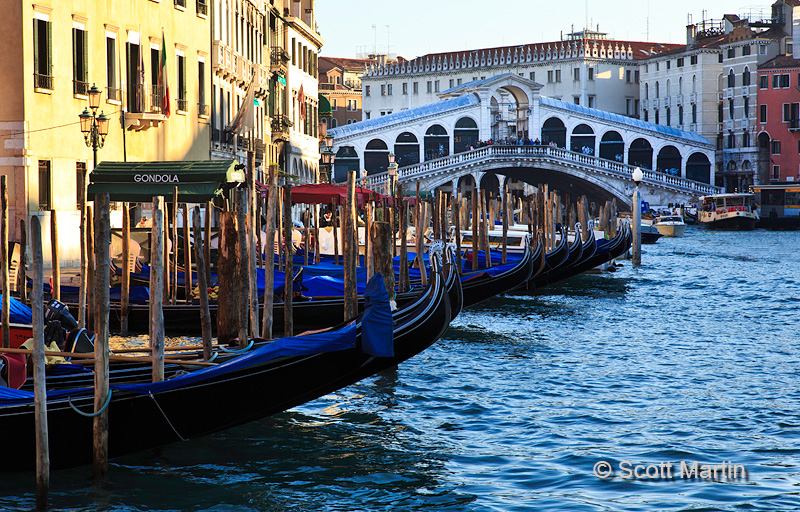
.
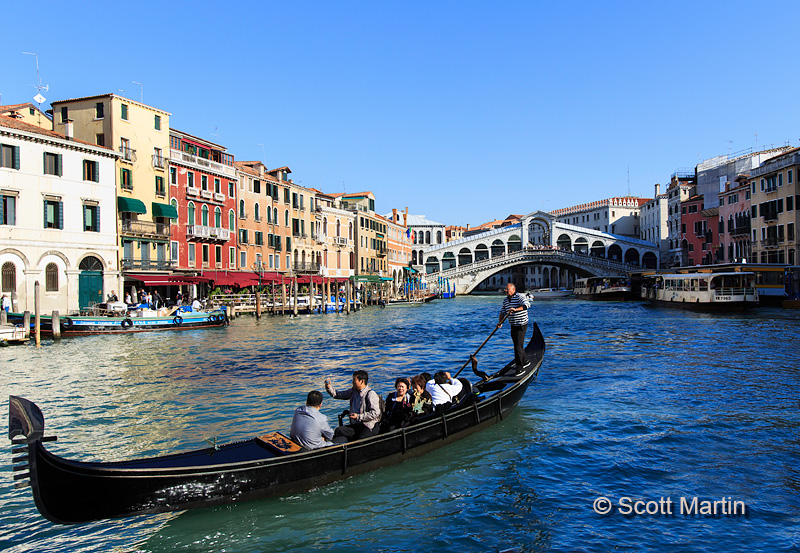
There are about 450 Gondoliers in Venice and based on tradition, you are born a gondolier in that a gondolier’s training and licence is passed from generation to generation, typically from father to son, however the first female gondolier in over 900 years was licensed in 2010. To be a gondolier in Venice makes one part of a proud and revered profession which I believe is captured in this next image.
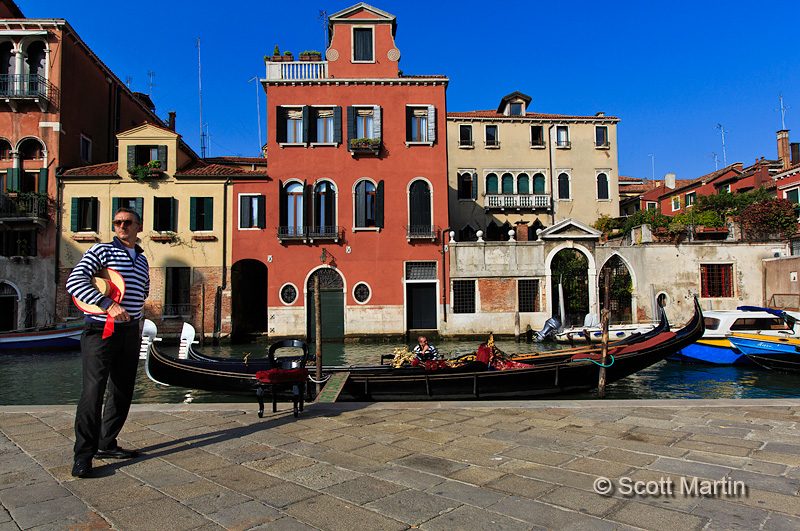
There are many quaint boutique type hotels in Venice and staying in the city adds to the charm of visiting Venice. A good example of this type of hotel is the one we stayed in, which began life as a fifteenth century palace and I would highly recommend. In fact, click here to visit their website.
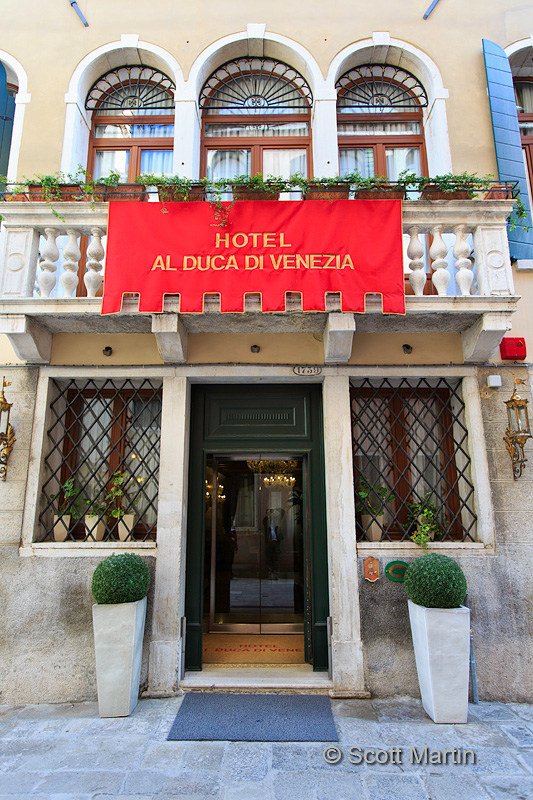
There are also hotels on a much grander scale. This angelic marble statue marks the stairway leading to the upper floor drawing room of one of Venice’s more spectacular hotels.
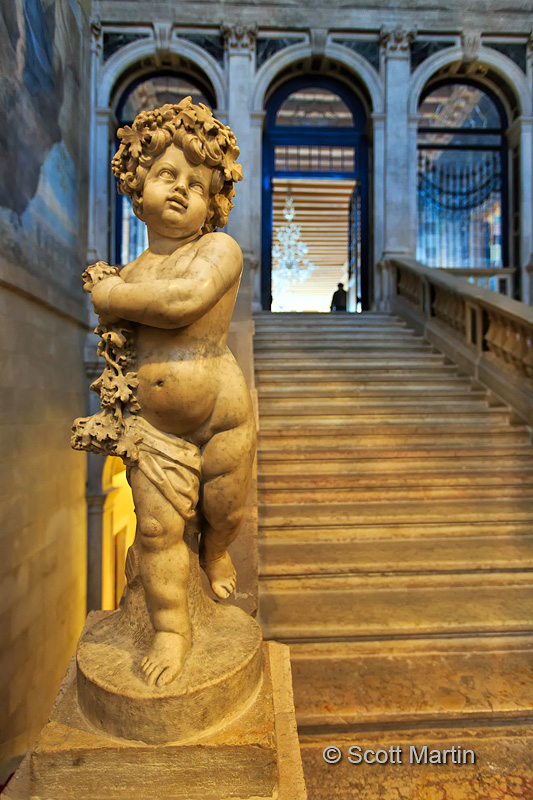
.
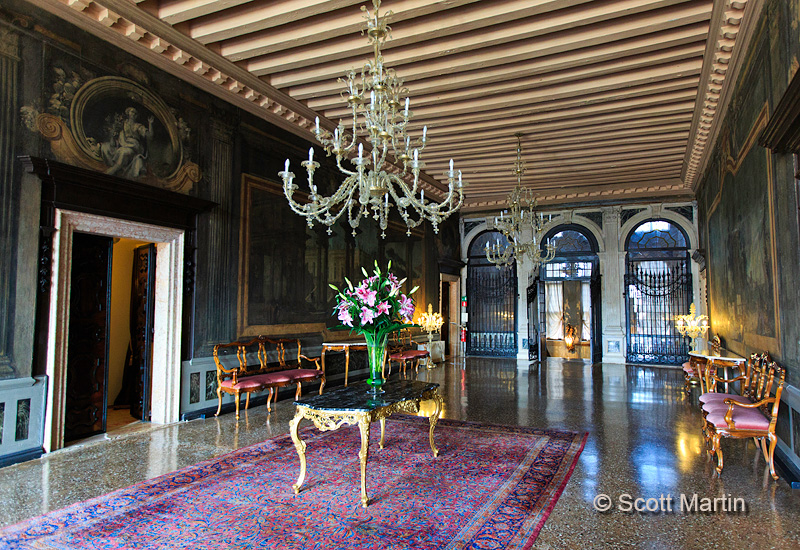
Perhaps the best known landmark of Venice is the Piazza San Marco, or as Napoleon referred to it, the drawing room of Europe. The vast expanse of the piazza can easily accomodate tens of thousands of people and it is certainly the social centre of the city.

St. Mark’s Basilica dominates the east end of the Piazza San Marco while its campanile (a stand alone bell tower associated with a church) rises proudly from the piazza.
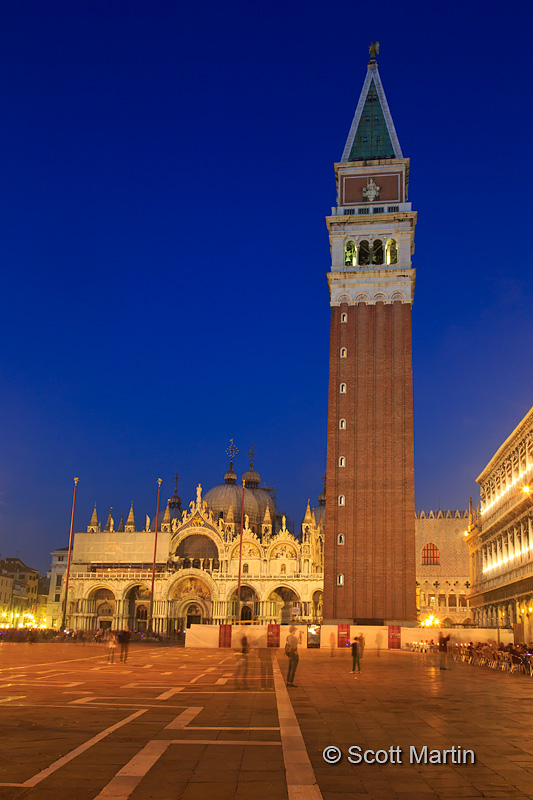
At the south east end of the piazza is another smaller area known as the Piazzetta di San Marco which runs between the Piazza and the lagoon and is bounded by the Marciana Library and Archaeological Museum on one side and Doge’s Palace on the other.
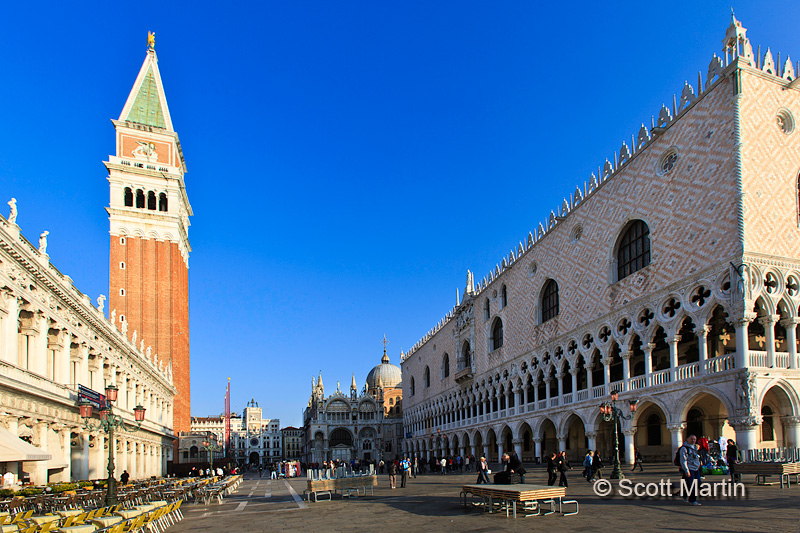
The objects that look like picnic tables in the fore ground are actually stacked portable walkways that are found throughout the public walkways of Venice. When needed they are separated and lined up end to end allowing pedestrians to stay dry and walk around the city when it is flooded which happens approximately one hundred days annually.
The Library, Archaeological Museum and Column of St. Theodore, one of the two patron saints of Venice.
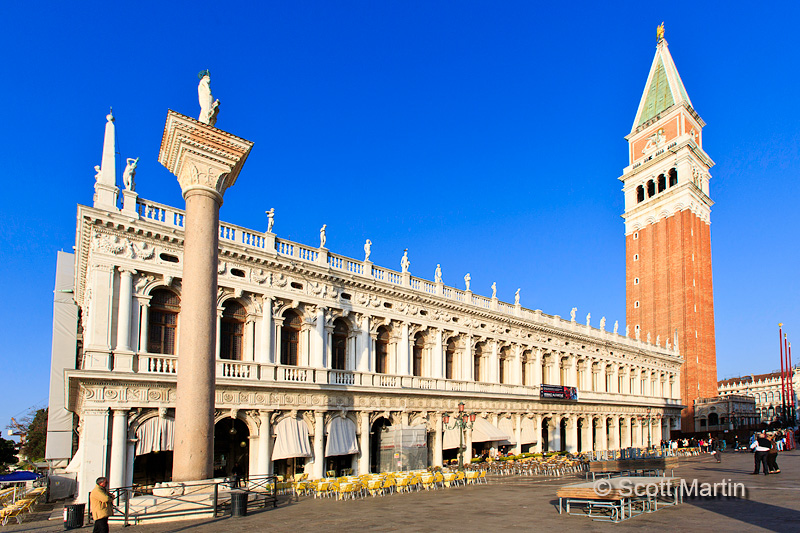
The Piazzetta taken from the lagoon with Doge’s Palace on the right side of the frame.
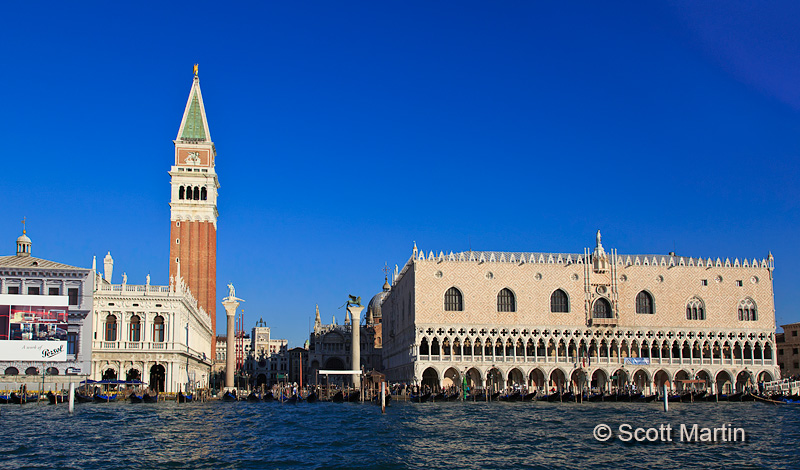
Next to Doge’s Palace, separated by a canal, is the New Prison. The famous Bridge of Sighs was built in 1614 to connect the two buildings. The bridge is completely enclosed with only small grated openings that allowed prisoners, freshly convicted by the magistrates in the palace, to catch their last view of freedom looking out through the grates to see the lagoon and the island of San Giorgio Maggiore as they were being led to the prison. The sighs they would utter gave the bridge its name.

In this next twilight image it is interesting to note the stark differences in architectural style of the palace on the left and the prison on the right.
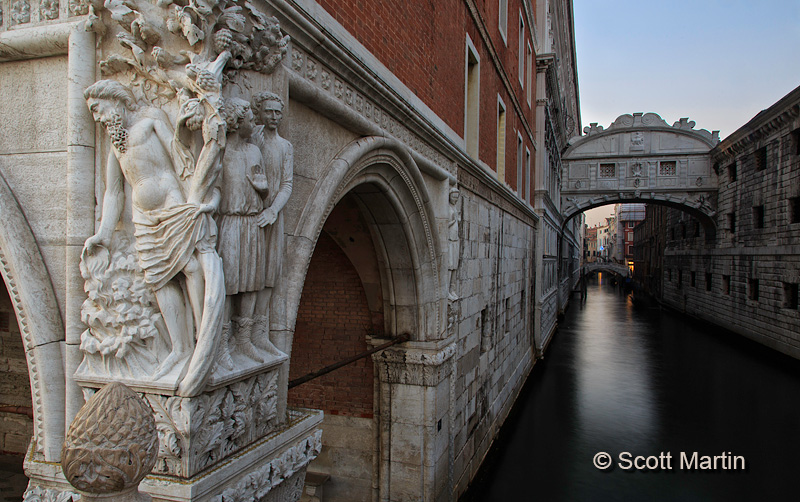
Venetians typically do not have freezers in their homes and rely on fresh food daily which is probably a good idea that we should all emulate. Markets are found throughout Venice and greatly add to the charm of the city.
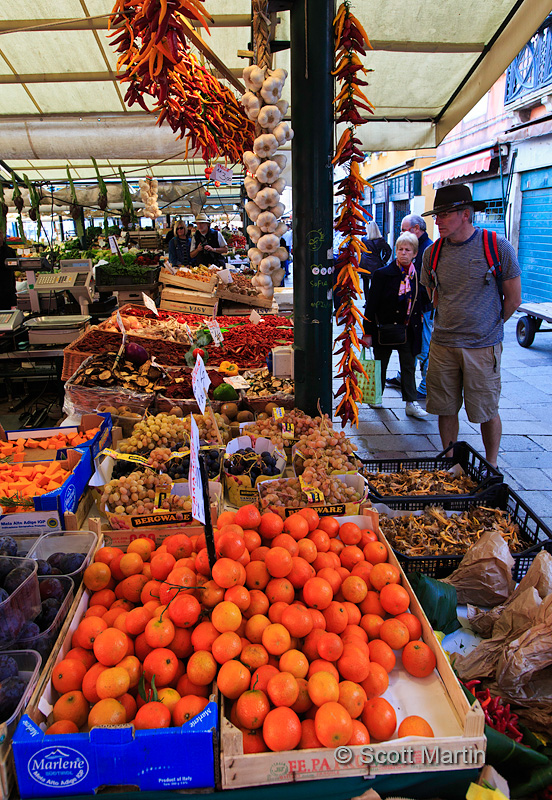
I trust you have enjoyed this more travelogue type view of Venice and that it has given you a good sense of feel for this wonderful city. The next blog post will be a more artistic photographic tour of Venice.
To close this post, we head over to the island of San Giorgio Maggiore and to the top of the bell tower of the Church of San Giorgio Maggiore which provides the perfect vantage point for a view of Venice. While at the top of the bell tower my 24-105mm lens suffered a catastrophic failure and and this was the last time I used the lens on our vacation. I’m sure the photographers reading this will feel a little sorry about my misfortune 🙂

.
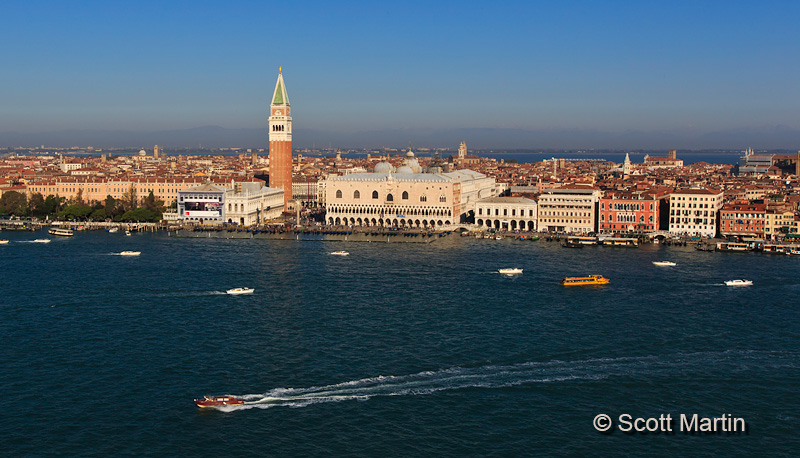










































































































Follow Scott Martin Photography